This was a most interesting and exciting day filled with adventure. But, it was also a day during which it was extremely windy. I could hear this early at dawn when I woke up a little. I was woken both by the clear sound of the wind, as well as because at some point the imam called for the prayer from the minaret of a nearby mosque.
When I finally got up and got dressed, I went to the kitchen where Shriya made a traditional breakfast. By this time I was well accustomed to it and I usually had such things for breakfast at the hotel (generally I mostly like to eat local food), but here I also paid close attention to what he, for instance, put over humus (sumac, cumin and olive oil) or over labneh (za’atar, sumac and olive oil). In this way I could imagine that back at home I would be able to make similar appetisers and then invite some friends for a “Jordanian” evening. In addition to the savoury part of the breakfast, there was also a sweet one – some sweet cream over which he put a couple of figs preserved in sugary syrup made by his mom. It was fantastic! And there was also a baklava. What a breakfast that was!
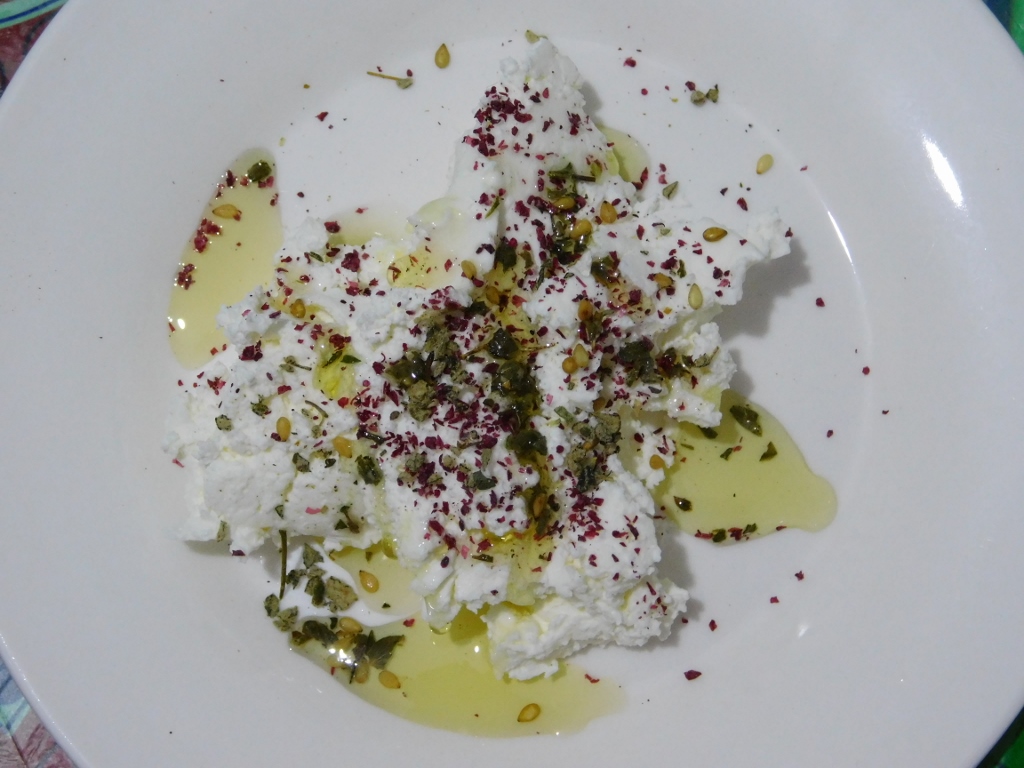 Labneh
Labneh
Here is my recipe for humus which I make from scratch, i.e., from dry chickpeas, but you can also use the ready to eat chickpeas in a can.
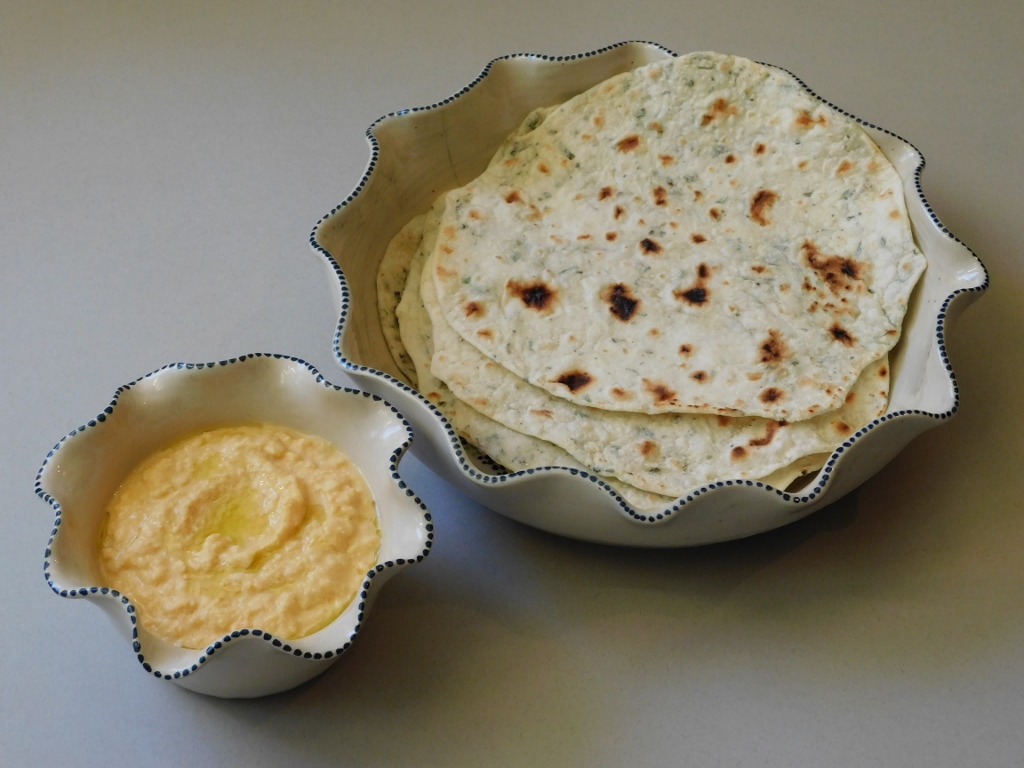 Humus
Humus
Humus
- 100 g dry chickpeas
- 1 tbsp of tahini paste
- juice of 1/2 lemon
- salt to taste
Soak well the chickpeas and leave overnight. In the morning, drain, pour some fresh water and add a pinch of bicarbonate of soda. When it’s cooked, drain. Keep some of the cooking water in case your humus is too dense.
Although humus is traditionally made by hand, I use hand blender in order to get to the humus I like. So, add to the chickpeas the rest of the ingredients and you can also put in some black pepper and garlic, and then blend until creamy.
As for Kerak, after the breakfast, the landlord asked me if I would go to the castle, as planned, and I confirmed it.
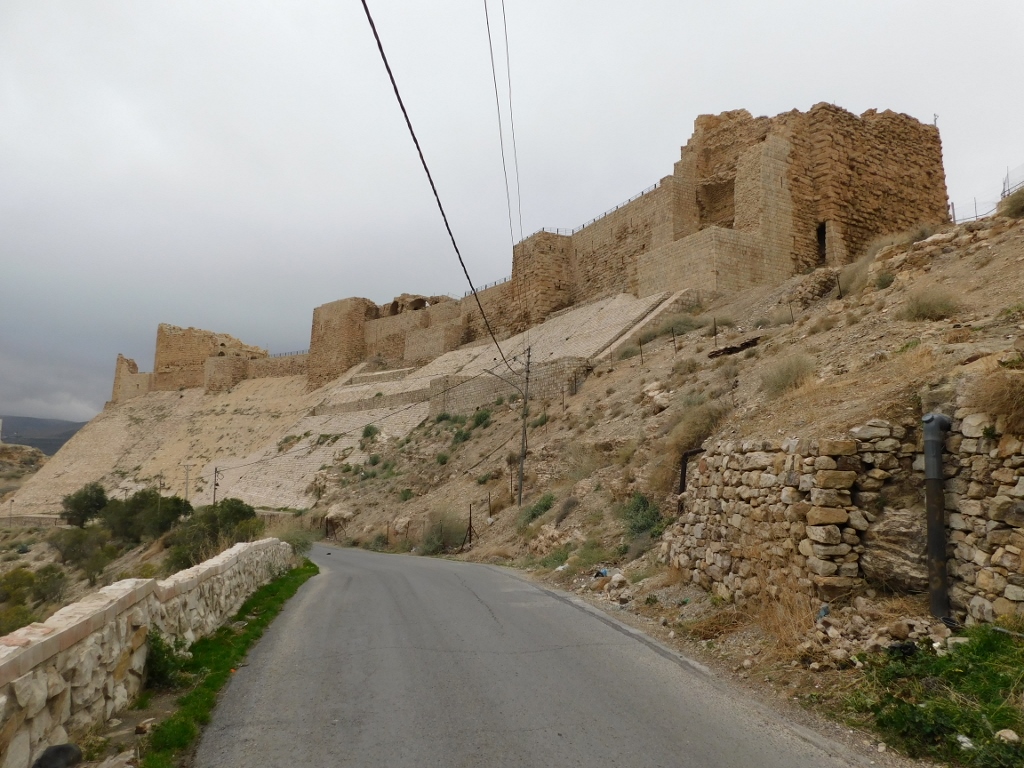 Karak Castle seen from the “back side”
Karak Castle seen from the “back side”
When I started going towards the entrance into the castle, I also took a photo of the house in which I stayed here, as well as the bus station that was way down at the foot of the hill.
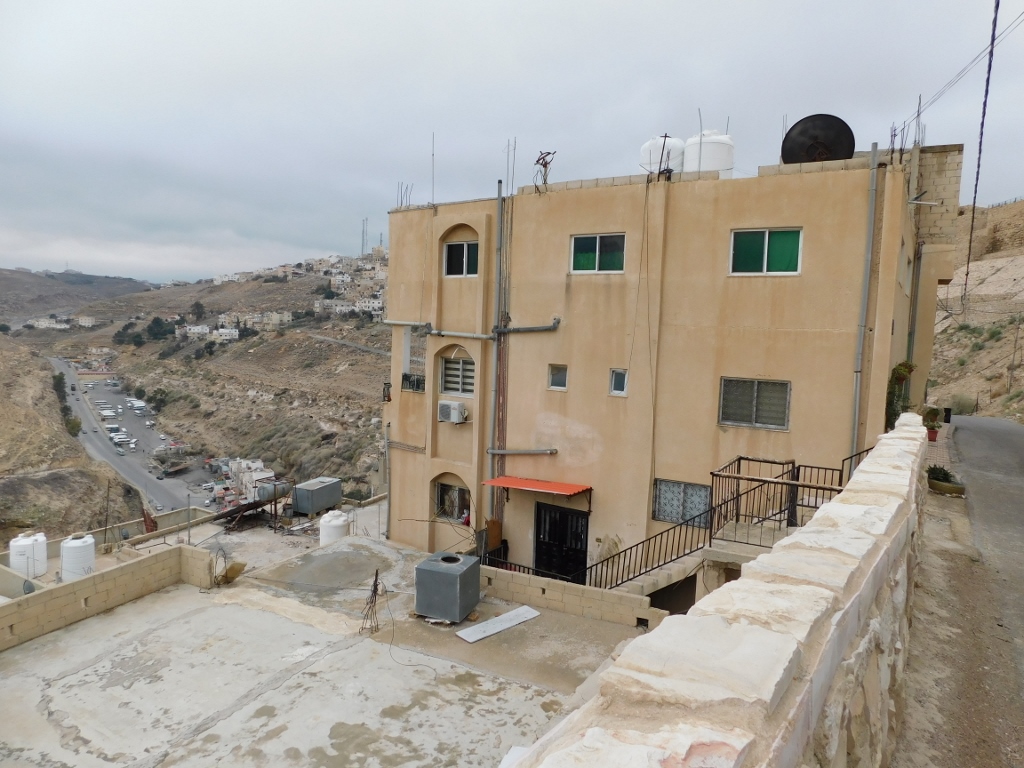 Parts of Karak: the house in which I rented a room, plus the bus station at the foot of the hill
Parts of Karak: the house in which I rented a room, plus the bus station at the foot of the hill
Although I was well dressed, as soon as I got out, it was clear that it was exceptionally windy with temperature around 0 degrees C, which meant that it was very, very cold. But, I felt that coldness only on my face; everything else was well protected. I even had excellent gloves, but the problem arose when I wanted to take a photo of something, as well as later in the castle when I took photos standing in open areas, since the wind pushed me and jerked my hands, so I could barely manage.
The entrance into the castle was not far away, so I could soon buy the ticket and start with the sightseeing. There was also a Jordanian flag here that helps illustrate the strength of the wind.
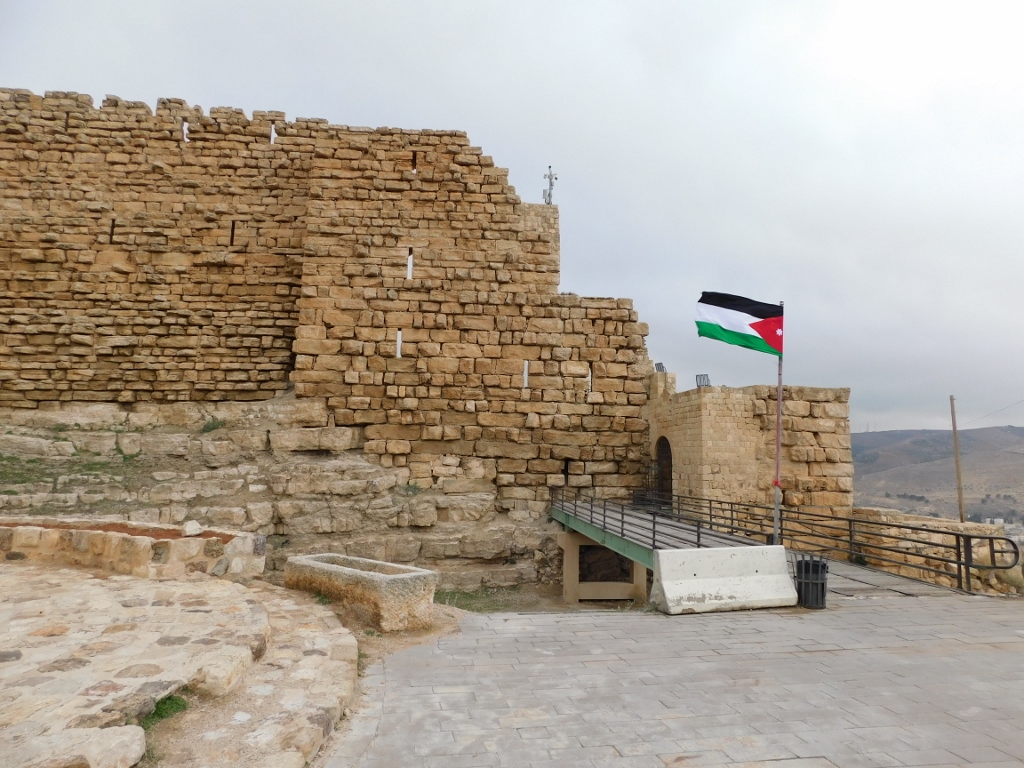 Entrance for the visitors of Karak Castle
Entrance for the visitors of Karak Castle
If the photo above is not illustrative enough, here is a short video:
The first thing I wanted to take photos of, once I entered the castle, was the view at Wadi Karak, the valley that in the westbound direction leads down to the Dead Sea. This only goes to show that the castle held an exceptional strategic position. Although the slopes of the hill on the top of which the castle is are somewhat shorter towards the other points of compass, taking up of the castle was certainly a great feat, since the slopes are very steep on three sides, while on the fourth side there is a good and comprehensive view.
 View to the west from one of the terraces of Karak Castle
View to the west from one of the terraces of Karak Castle
Karak Castle was built by Crusaders, although there were human activities here even earlier. Karak is mentioned in the Old Testament and it also appears in the Byzantine mosaic map from Madaba (https://www.svudapodji.com/en/jordan-1/).
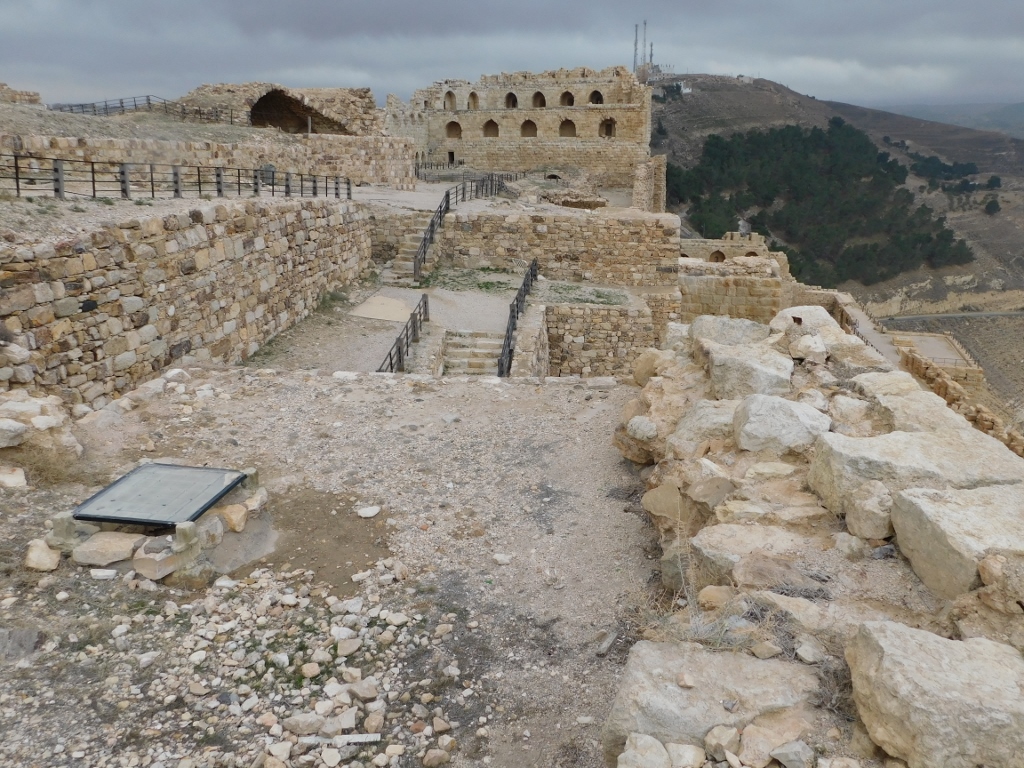 Karak Castle, a detail
Karak Castle, a detail
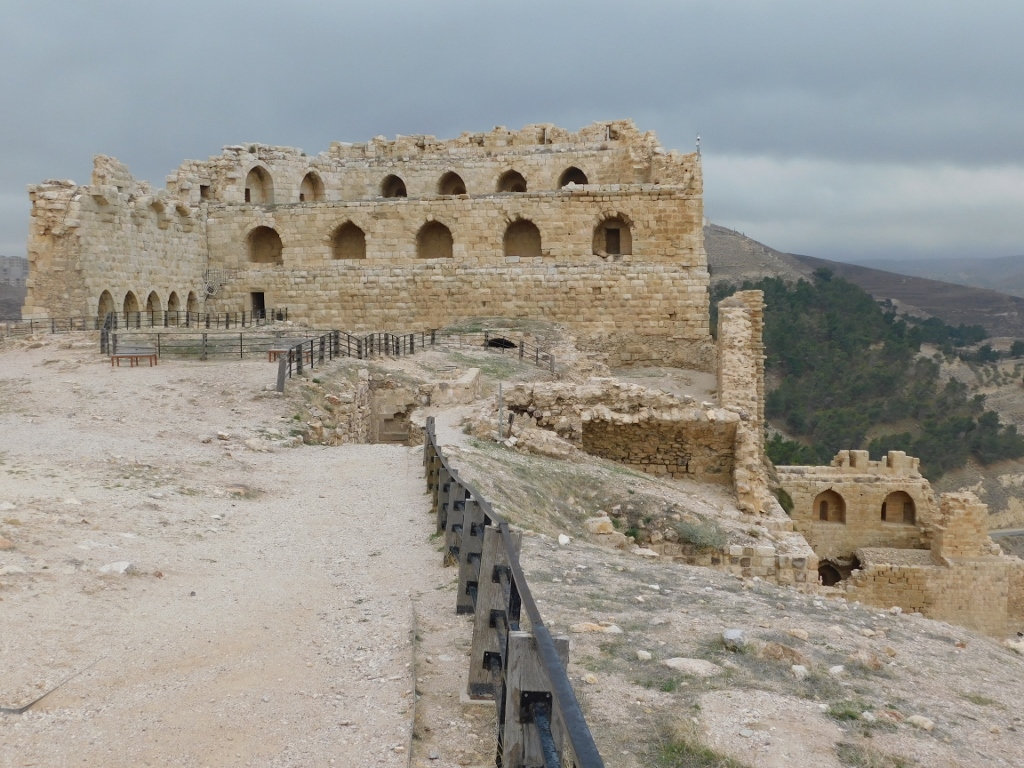 Karak Castle, a detail
Karak Castle, a detail
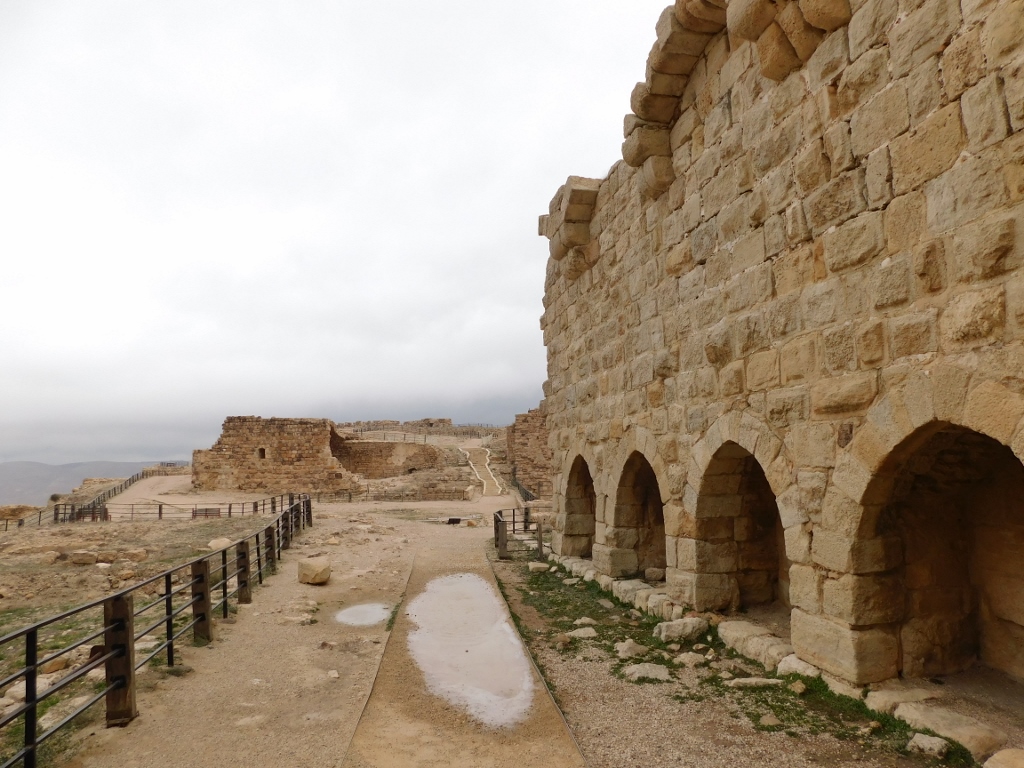 Karak Castle, a detail
Karak Castle, a detail
The beginning of the construction of the castle and this stronghold is linked to the year 1142 CE. The castle has seven levels, some of which are dug way deep into the rocky hill on which the castle was built. The visitors are told that they can switch on the lamps on their mobile phones and then explore some of these hallways on their own. I was not interested in anything of the kind and only contented myself by peering a little.
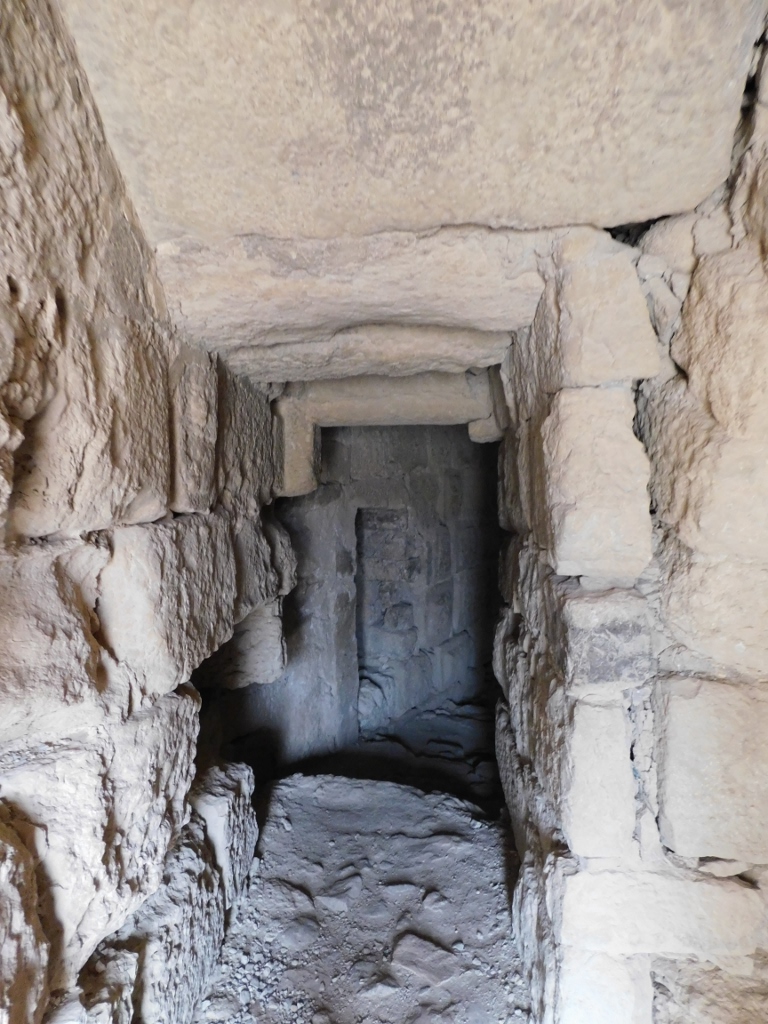 Karak Castle, a detail
Karak Castle, a detail
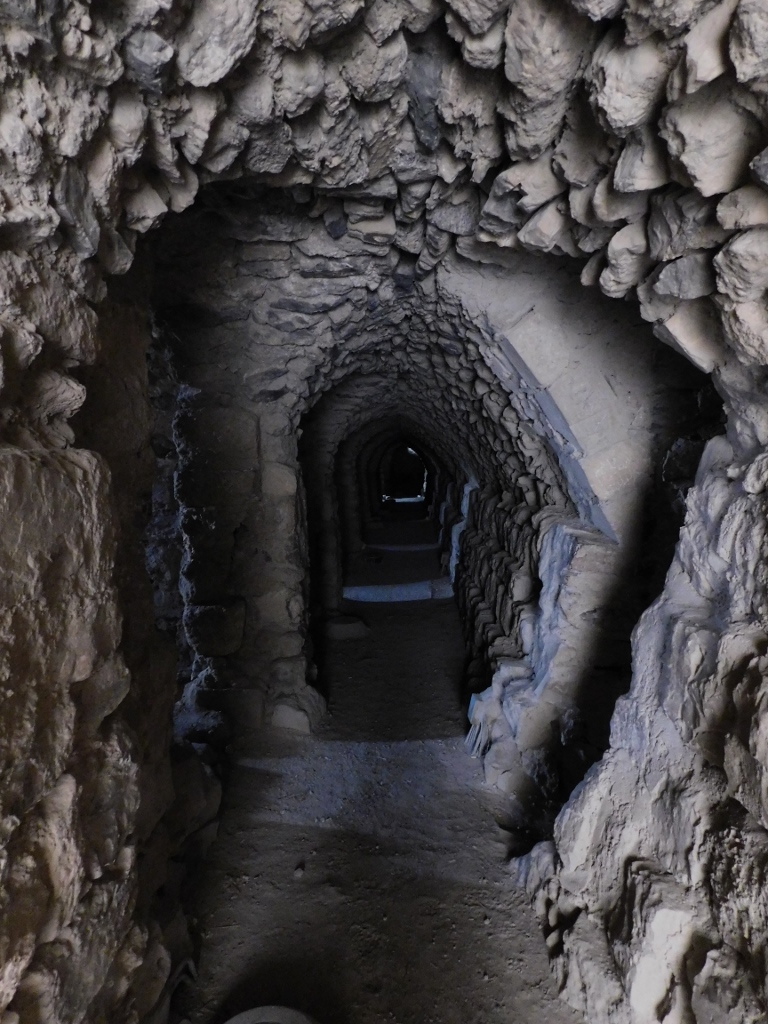 Karak Castle, a detail
Karak Castle, a detail
Still, there were some impressive large chambers that were also somewhat dark, but my visit took me there in order to get to different parts of the castle, so this was not a problem. On the other hand, taking into account that Ajloun Castle was quite nicely lit, I presume that these premises were left without artificial lighting on purpose in order to make them more mysterious and attractive for visitors.
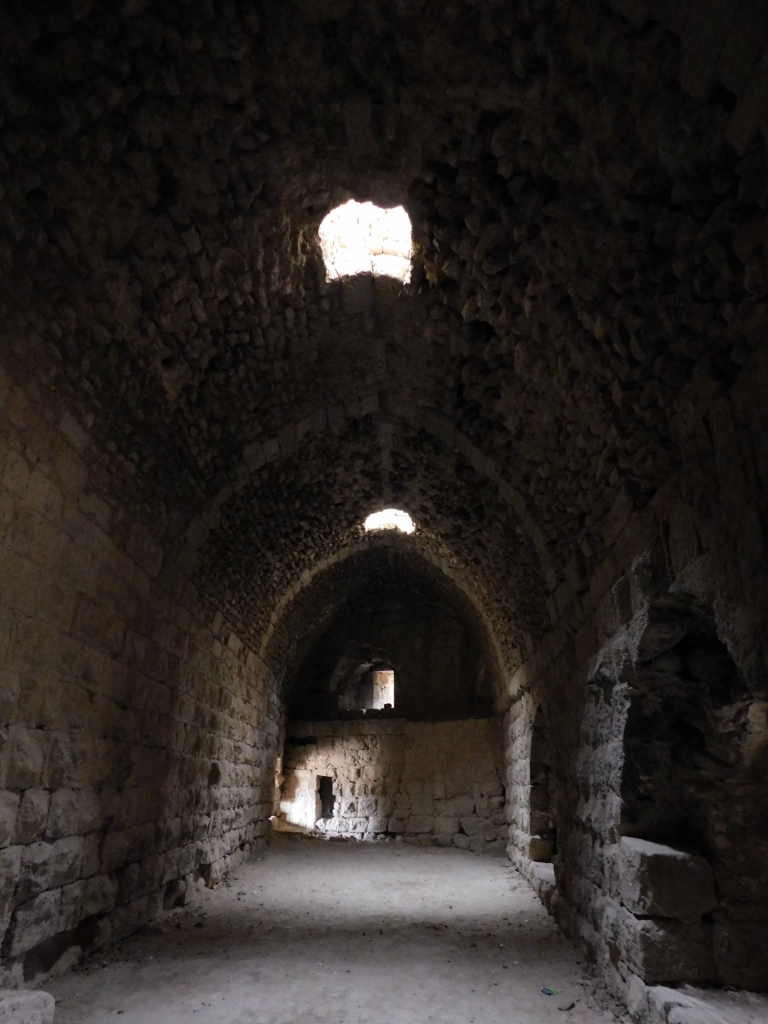 Karak Castle, a detail
Karak Castle, a detail
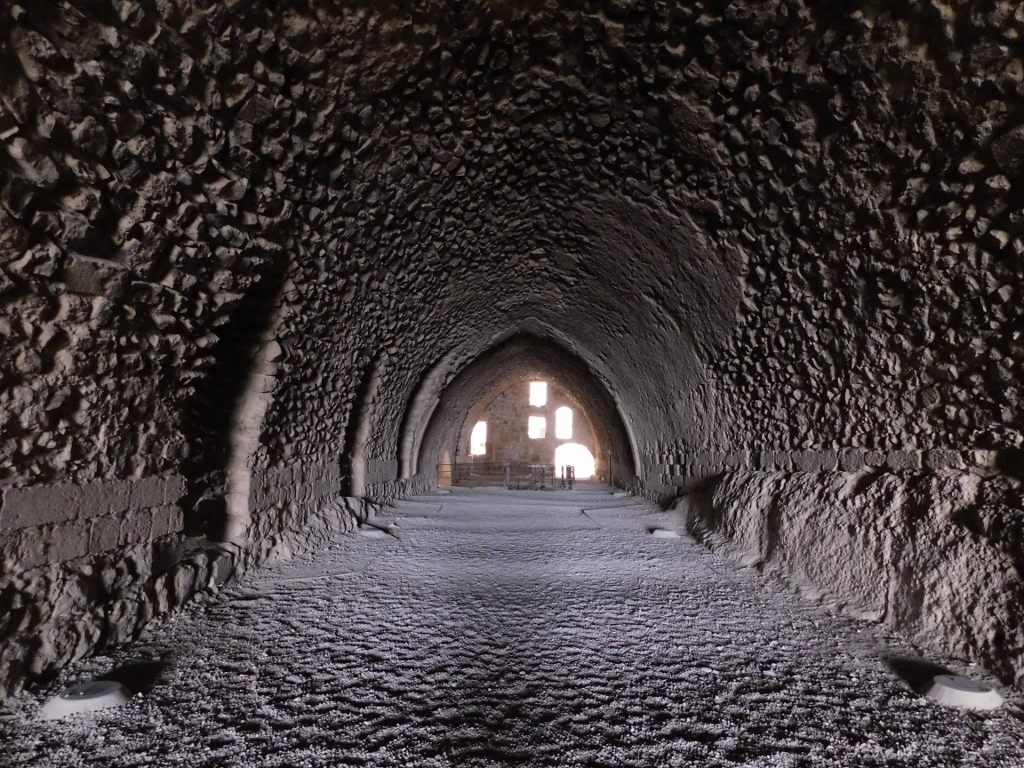 Karak Castle, a detail
Karak Castle, a detail
At some point, I was leaving an inner passage and going out, and there I noticed some very pretty stone decoration, which seemed particularly attractive bearing in mind the primarily military function of the fortress.
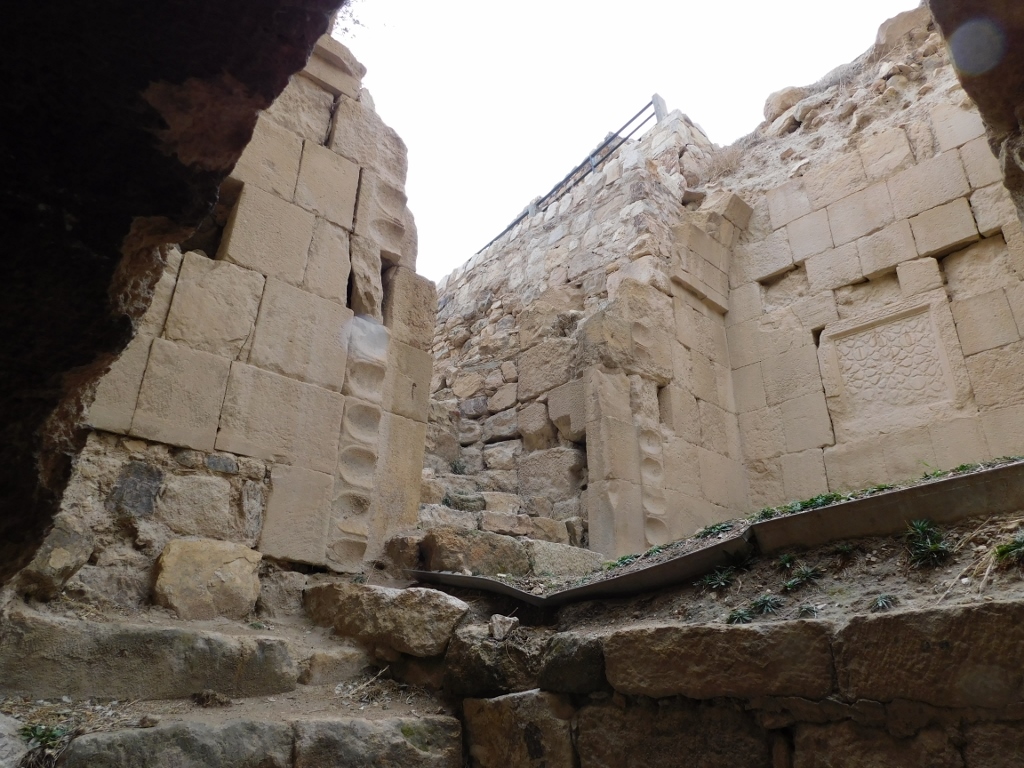 Karak Castle, a detail
Karak Castle, a detail
On the other hand, some other elements, such as the arch in the photo below, impressed me greatly. I find it utterly awesome how people arranged the stones that make up the arch and that hold the arch by leaning one against the other. This must be all quite clear to engineers and architects, but I was amazed.
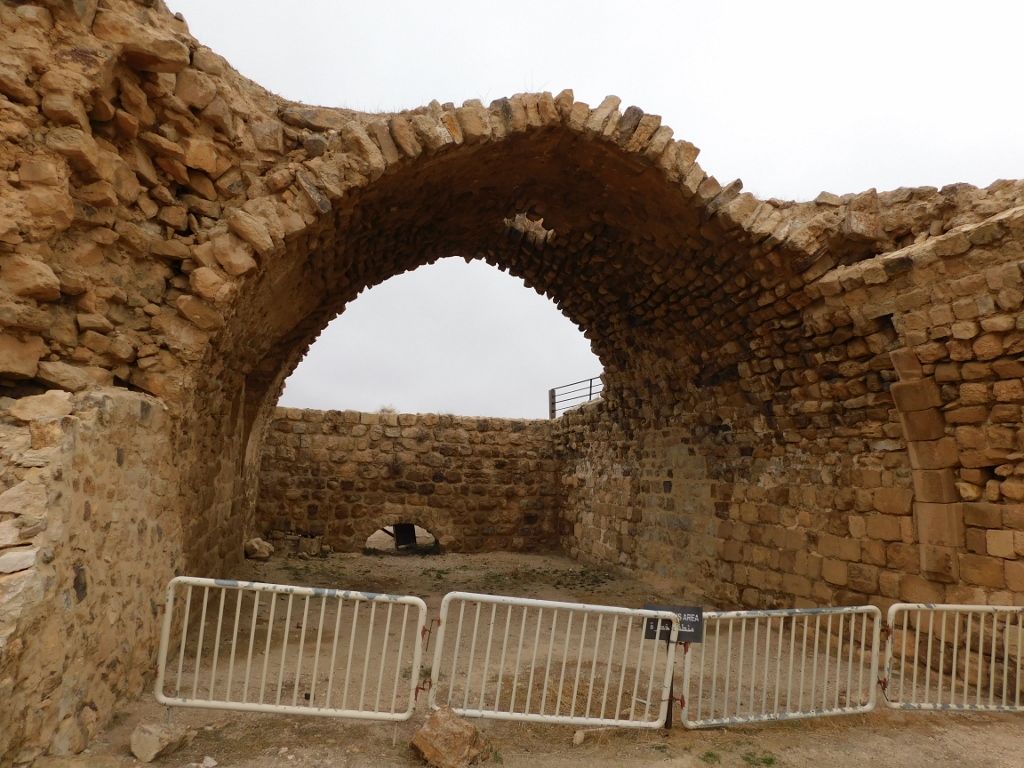 Karak Castle, a detail
Karak Castle, a detail
When I read about the history of the castle, a particularly ruthless Crusader/master of the castle caught my attention. I always find it fascinating when different sadists try to sell a story that they are doing it all “in the name of God,” while being in fact despicable specimens of the human kind. Be as it may, it was right during the reign of that Crusader that famous Saladin, the Muslim military leader, was trying to conquer Karak Castle. I know that I read much earlier that despite being a warrior and a military leader, Saladin was also, if I can put it that way, an exceptional gentleman in all of that. There is even a very interesting story about the first siege of Karak Castle by the Muslim forces led by Saladin. (By the way, that first siege was not successful and neither was the second one. The Muslims conquered the castle only in 1188 after the victory in the Battle of Hattin.) In 1183, during the first siege, Saladin learned that the son of that cruel Crusader ruler was getting married in the castle right at the time when the siege was taking place. Saladin then sent a message asking where the newlyweds were and he ordered his troops not to aim at that part of the castle. There, a gentleman and a noble person, even when fighting a war.
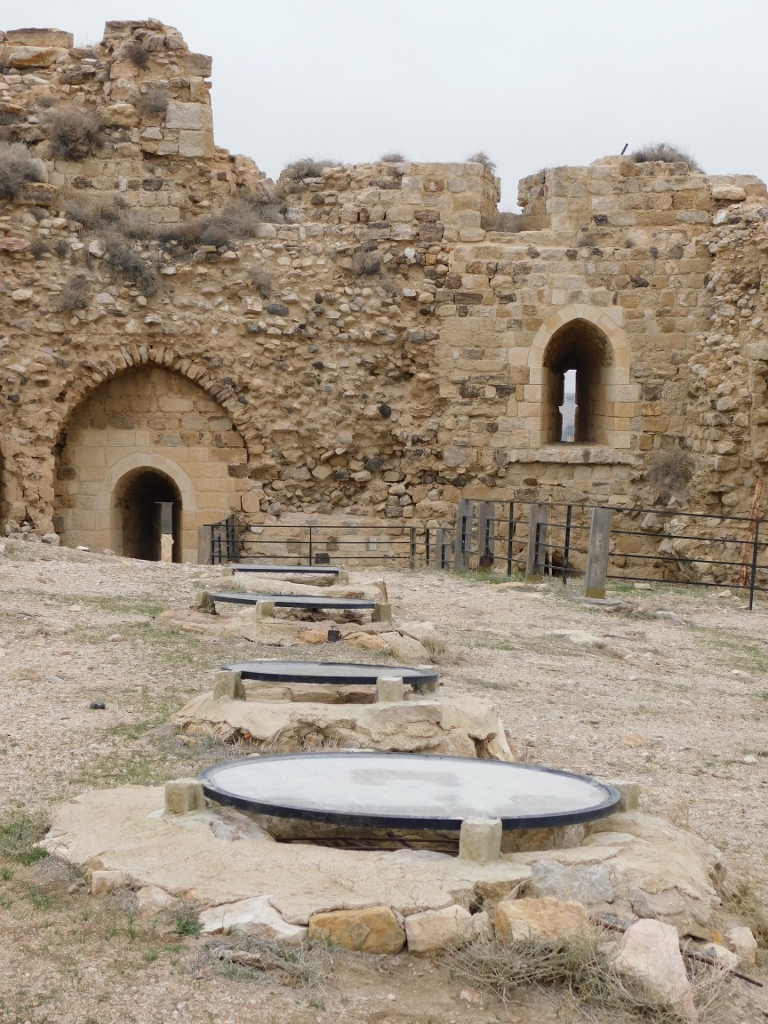 Karak Castle, a detail
Karak Castle, a detail
Although it is possible to spend even a few hours here, since I had other plans for the day, I just went briefly to the east ramparts of the castle from where it is possible to see parts of Karak city and I could also see the house in which I stayed. Then I went back to the west ramparts and once more admired Wadi Karak from there.
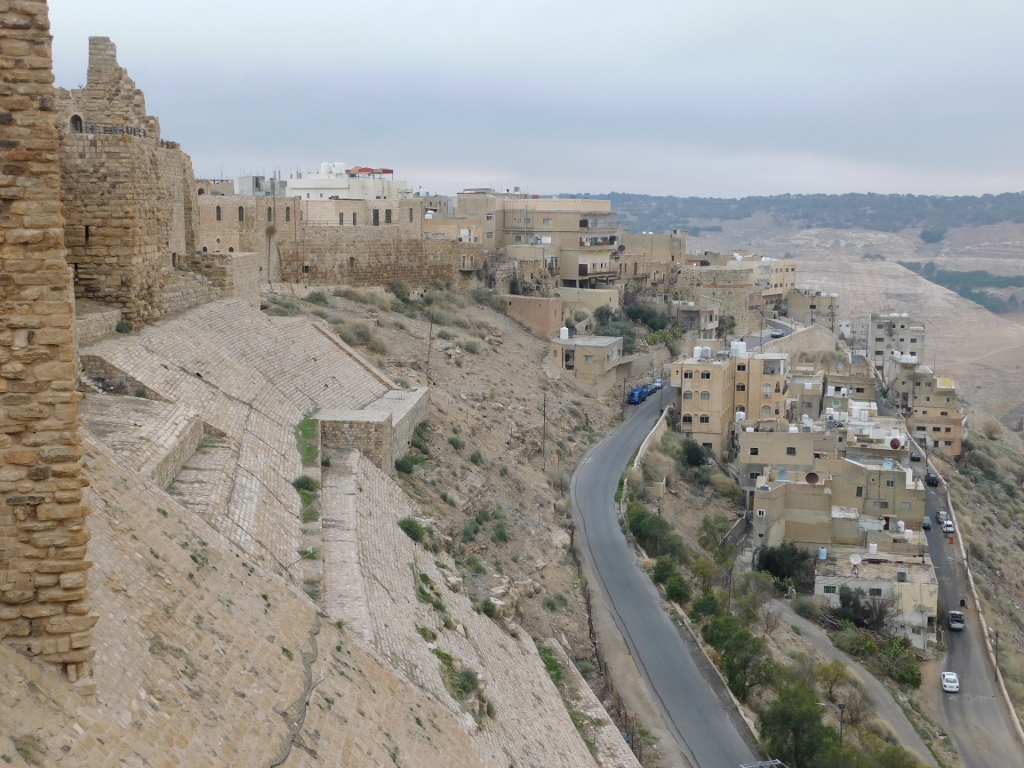 Karak Castle, east ramparts and parts of the contemporary city
Karak Castle, east ramparts and parts of the contemporary city
 Karak Castle, west parts of the castle and Karak valley leading down to the Dead Sea
Karak Castle, west parts of the castle and Karak valley leading down to the Dead Sea
Now I went back to the B&B and there I met Abdullah who was a friend of the owner of the B&B and the person that would drive me by his car to the excursion I had conceived. It was all significantly facilitated by the fact that he spoke English quite well, unlike the landlord with whom I communicated via digital interpreter on his mobile phone. We left soon.
Since we were going now to the areas east of Karak, where there is the desert, the roads were often quite straight.
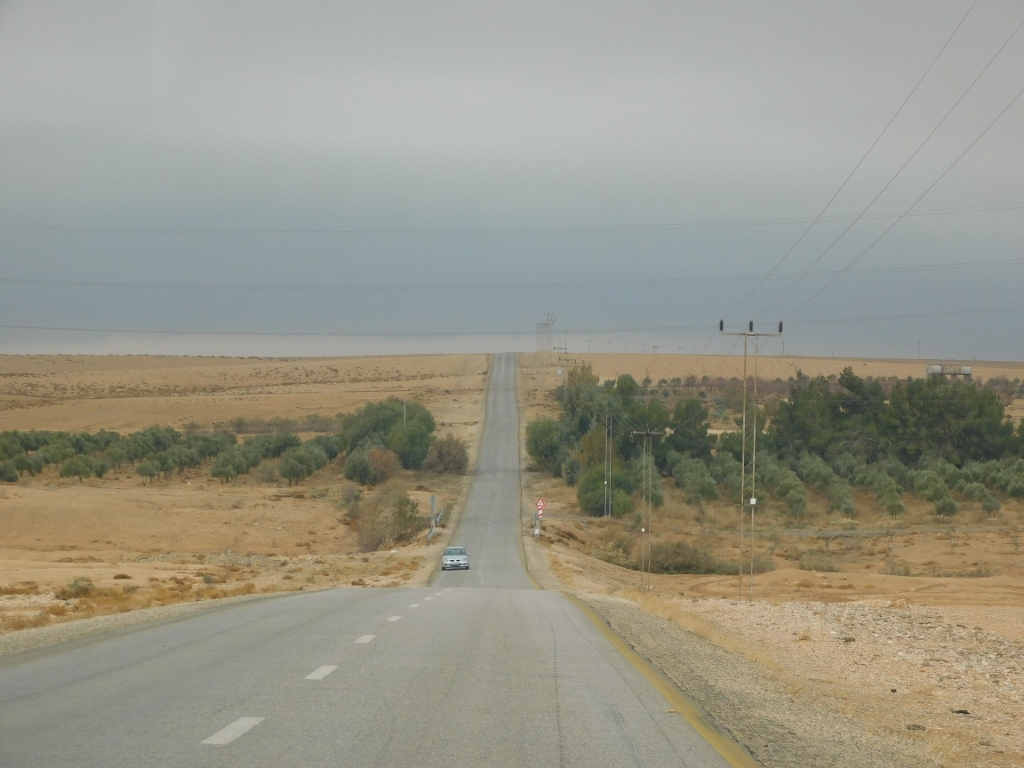 Detail from a road east of Karak
Detail from a road east of Karak
First we drove along the eastbound road and thus we reached the Desert Highway where we turned to the north. After some 35 km we turned to the west once again in order to get to the archaeological site of Umm er-Rasas.
 Umm er-Rasas, archaeological site in the middle of a desert
Umm er-Rasas, archaeological site in the middle of a desert
Originally, there was a Roman military camp built here, but over time a settlement that was active from the 5th century CE formed in this place. The site where archaeologists still need to excavate contains remains from the Roman, Byzantine and early Muslim periods (from the end of the 3rd century to the 9th century). The remains of as many as 16 churches have been found in Umm er-Rasas and some of them have very well preserved mosaic floors.
And this, what I have said in the previous paragraph, is more or less all that I knew about the place, but that did not discourage me at all. I bought the tickets together with Abdullah and then we started to walk around. Other than the two of us, there was absolutely nobody else at the site.
The only thing that helped us a little bit in getting our bearings were signs that gave the names of the structures that were there, but later on I managed to find some more information.
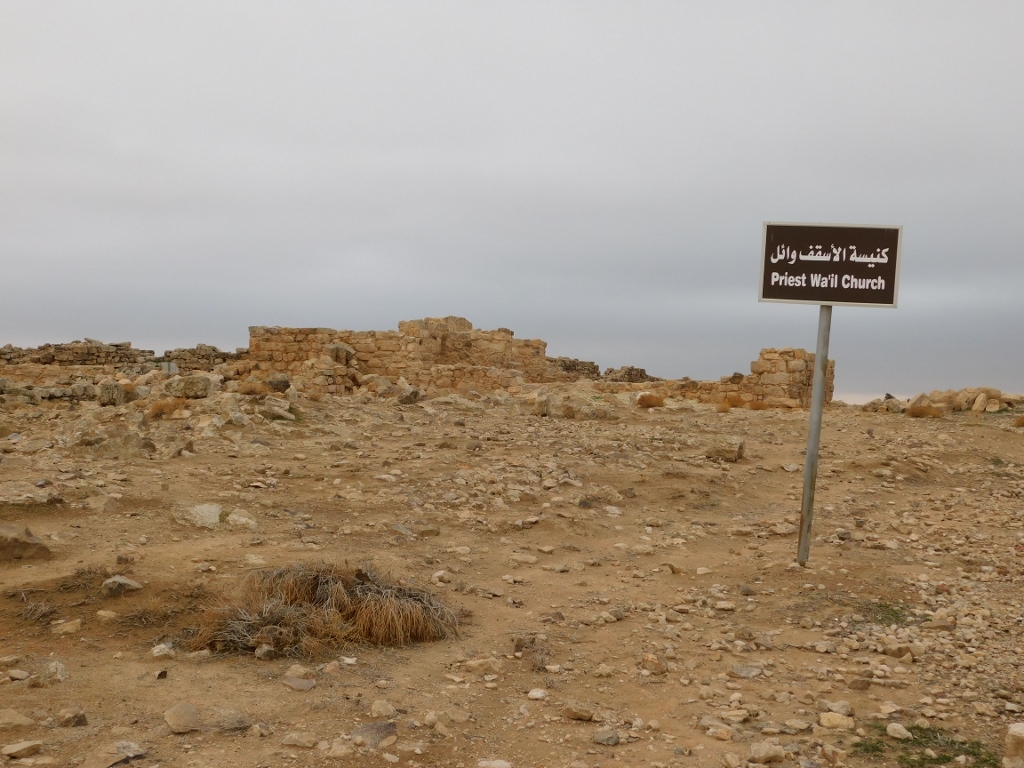 Umm er-Rasas, a detail
Umm er-Rasas, a detail
The small Priest Wa’il Church was built and paved in 585 CE.
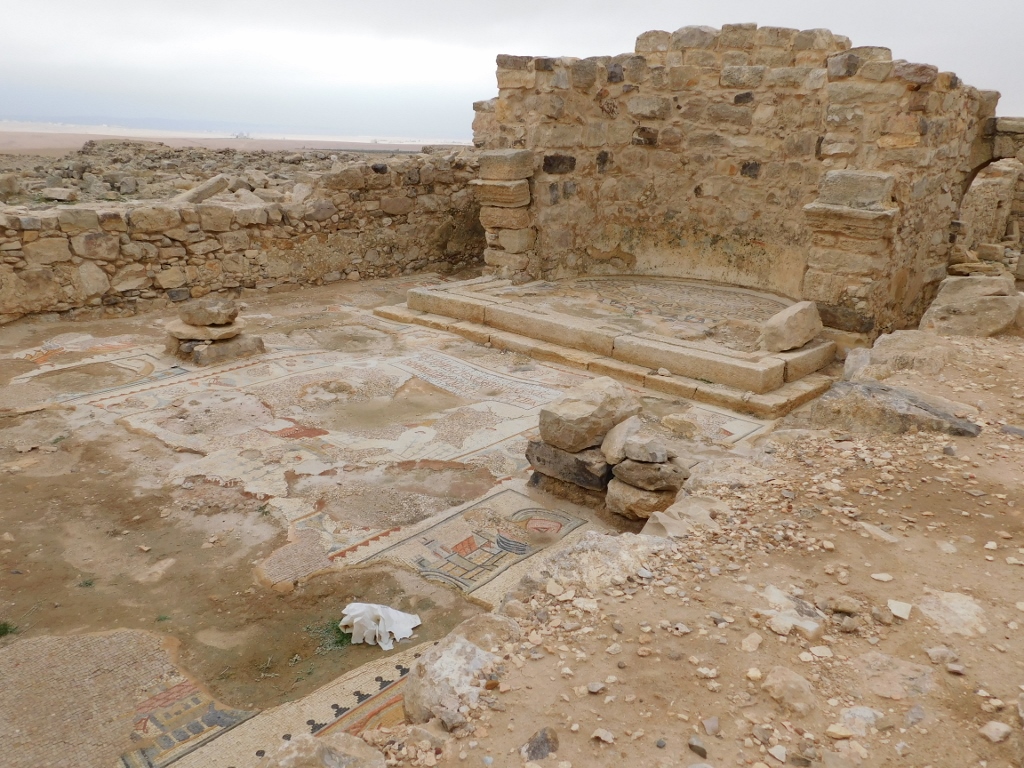 Priest Wa’il Church
Priest Wa’il Church
Although I could have certainly taken some better photos if I had approached the mosaics completely, I really avoided walking on them, since I think it is more than enough that they are exposed to the elements. They don’t need a horde of tourists, or even one, to walk over them. On the other hand, I am happy with the photos made while I was standing on the side.
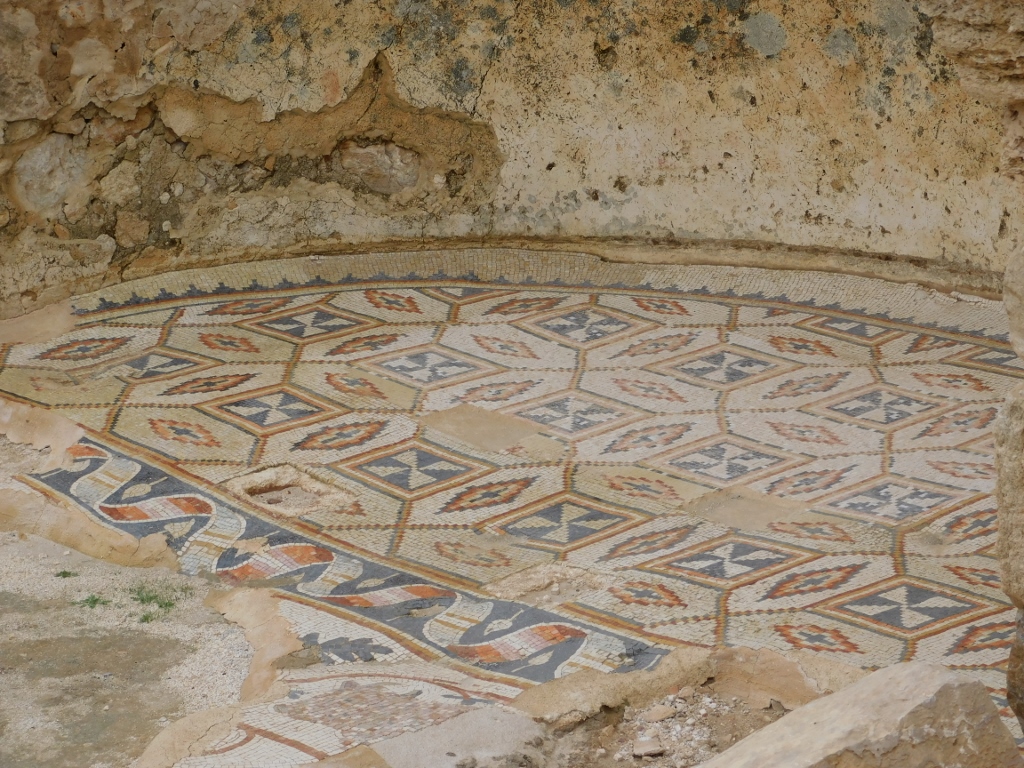 Presbyterium of the Priest Wa’il Church, a detail
Presbyterium of the Priest Wa’il Church, a detail
We also visited remains of the Church of the Tabula named like that because of the tabula ansata that was placed in its presbyterium and then we went to the Church of the Reliquarium. It was named like that on account of the reliquarium found under the floor of the presbyterium. The church had three naves and one, central apse, while its mosaics have been preserved in fragments.
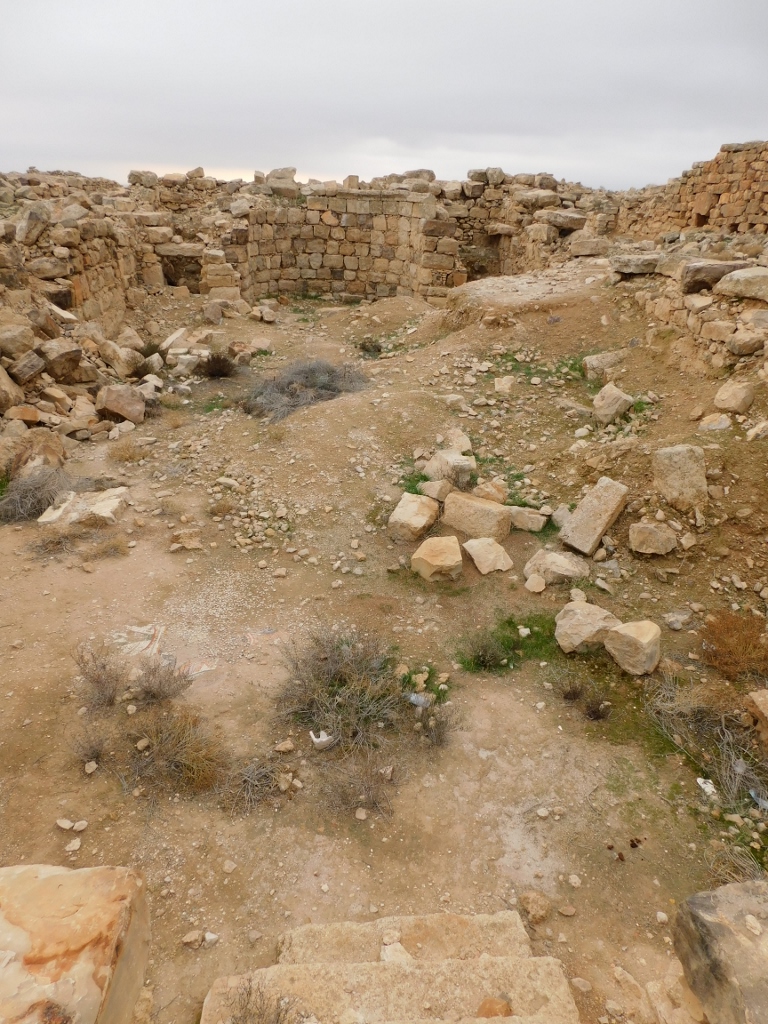 Church of the Reliquarium
Church of the Reliquarium
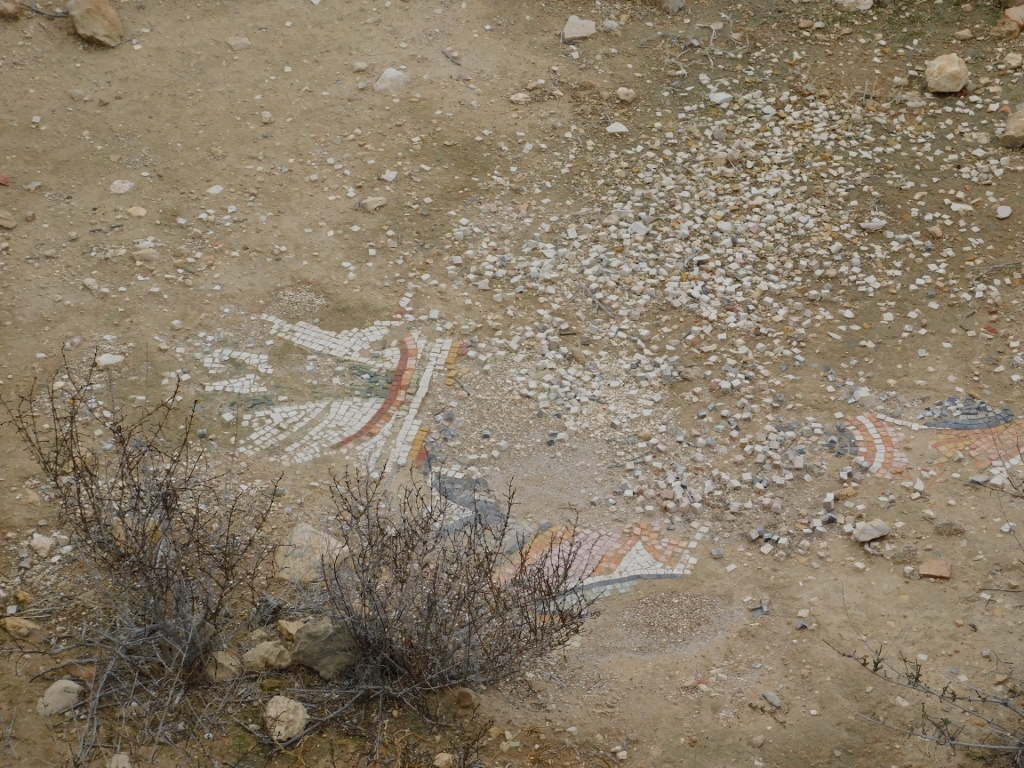 Church of the Reliquarium, a detail of the preserved mosaic
Church of the Reliquarium, a detail of the preserved mosaic
Then the visitor path led beside some residential structures.
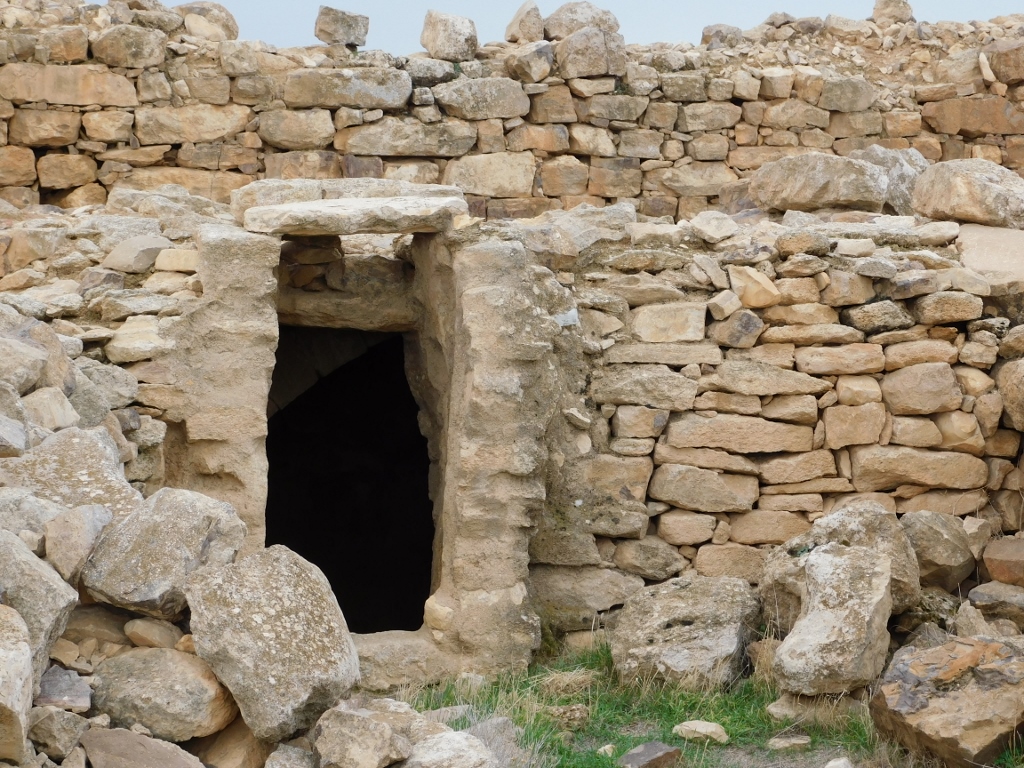 Remains of houses in Umm er-Rasas
Remains of houses in Umm er-Rasas
Here again I was delighted with the skilfulness in the construction of arches that even after 1500 years stand and carry the weight.
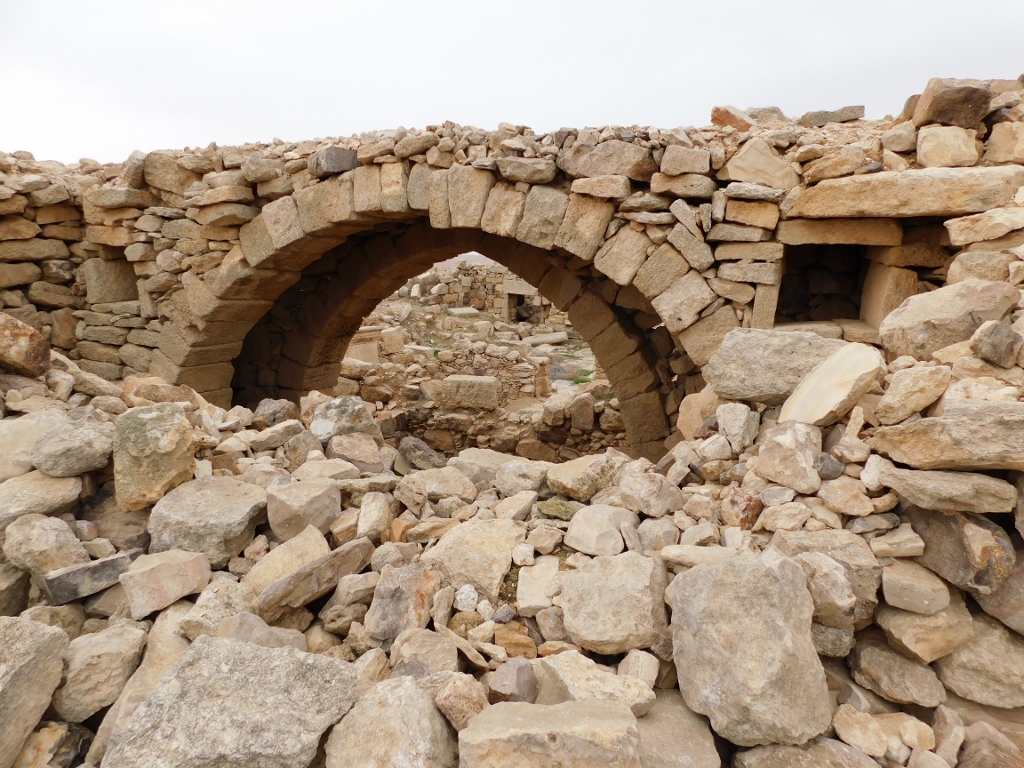 Remains of houses in Umm er-Rasas
Remains of houses in Umm er-Rasas
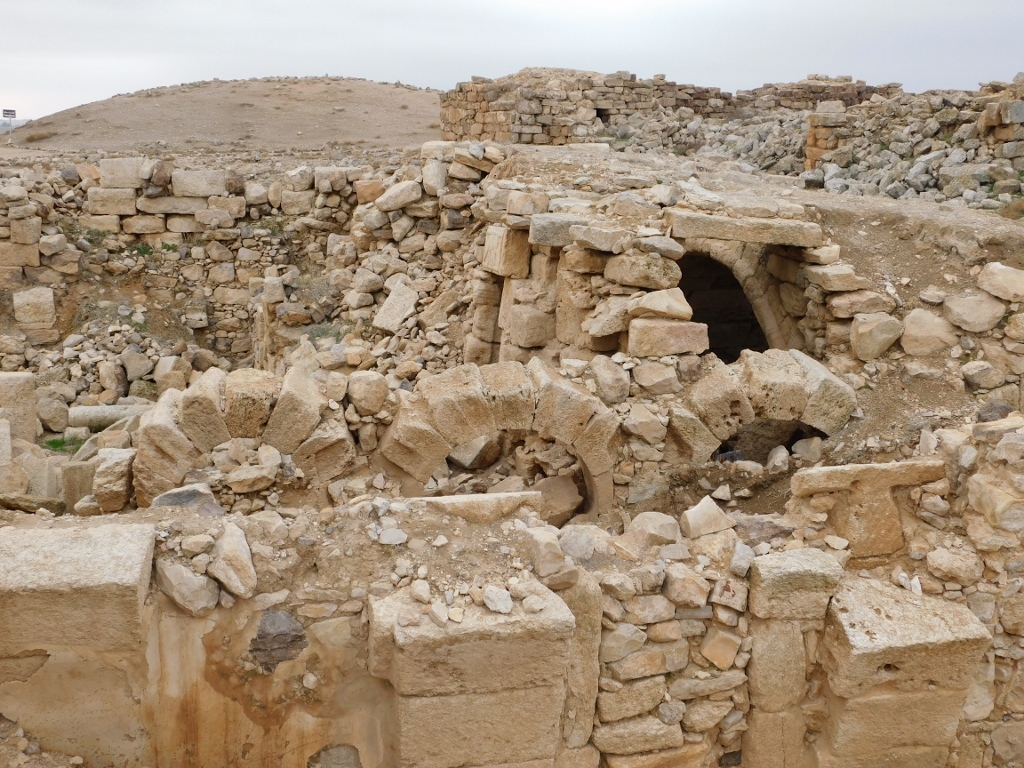 Remains of houses in Umm er-Rasas
Remains of houses in Umm er-Rasas
We also visited remains of a villa here. This is a large complex that has a spacious inner courtyard and several water cisterns.
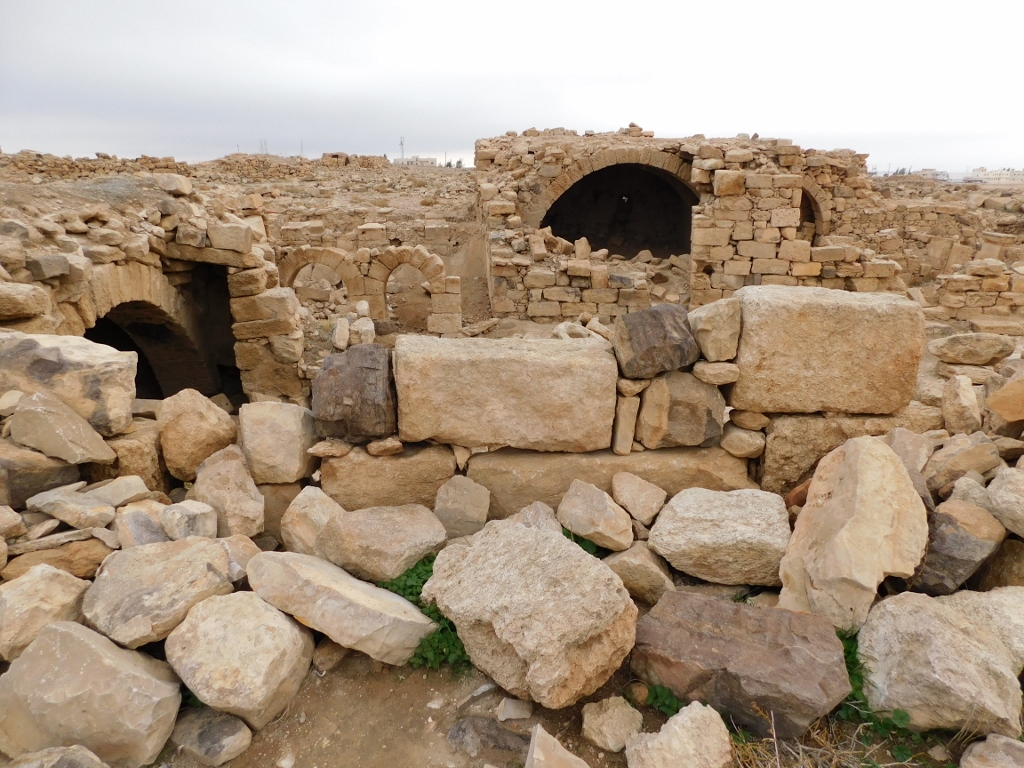 Remains of the villa in Umm er-Rasas
Remains of the villa in Umm er-Rasas
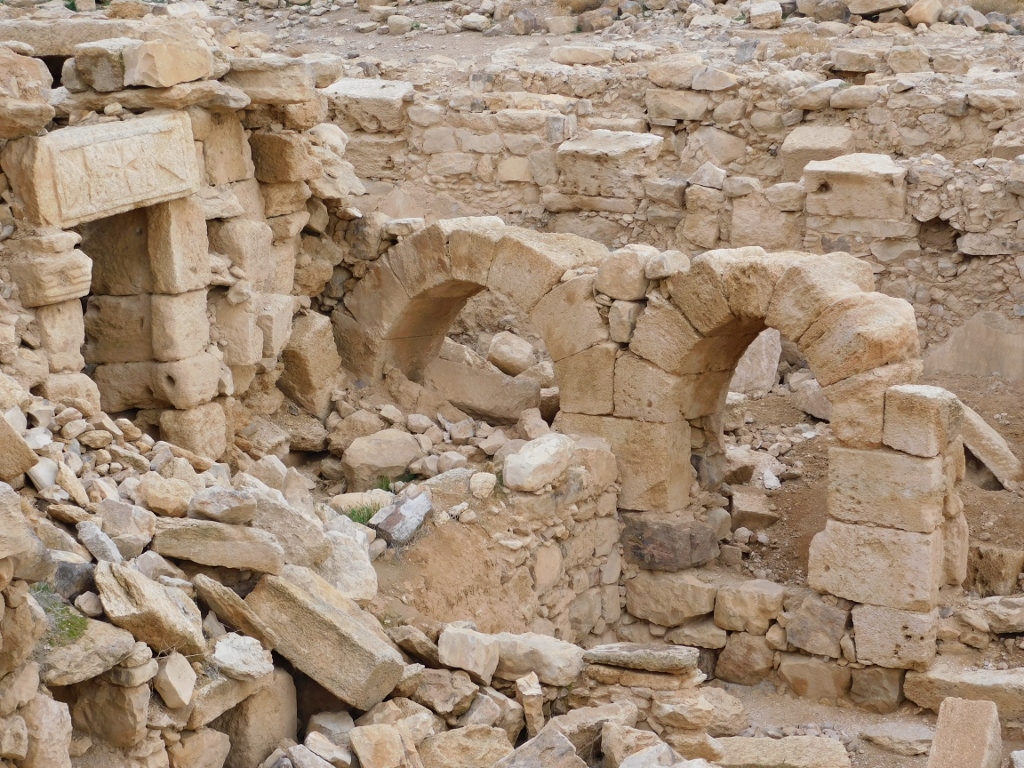
Villa in Umm er-Rasas – note the decorative lintel in the photo to the left
Then we walked past the Chapel of the Peacocks. It has been ascertained that the chapel was destroyed in an earthquake in the second half of the 8th century. Most of the roofing, the capitals, parts of the arches and the covering slabs were found during the excavations.
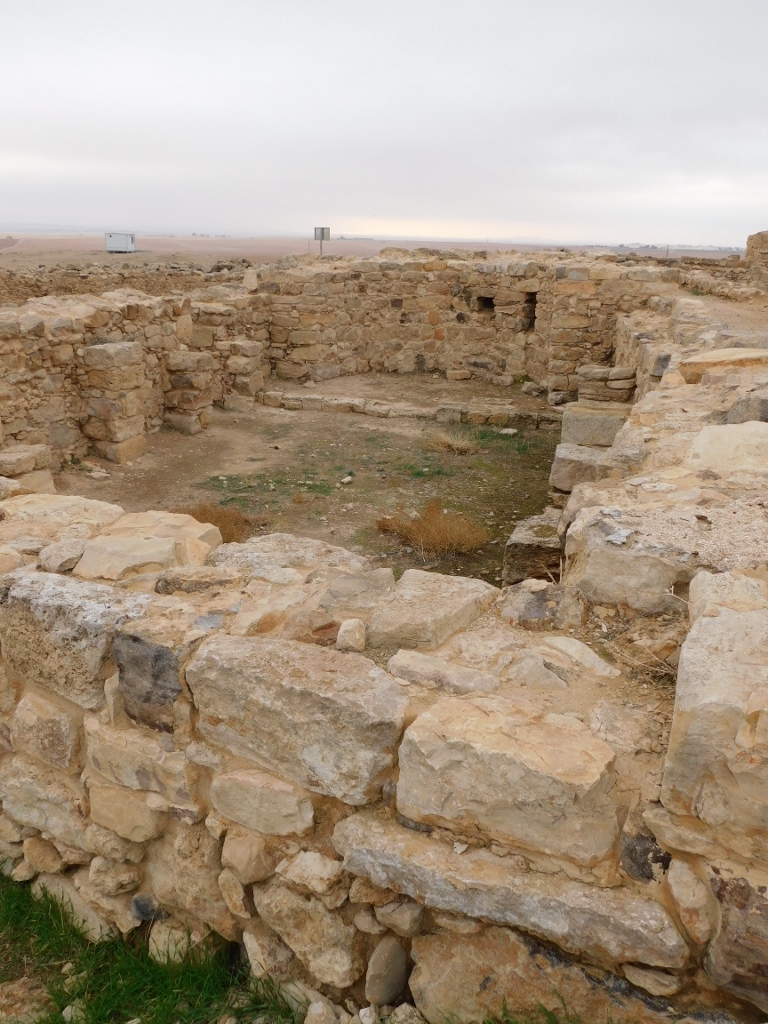 Chapel of the Peacocks
Chapel of the Peacocks
And then, Abdullah and I walked to the Lions Church built in the 6th century. This is in fact a large church complex that included the church itself, as well as numerous other rooms and courtyards.
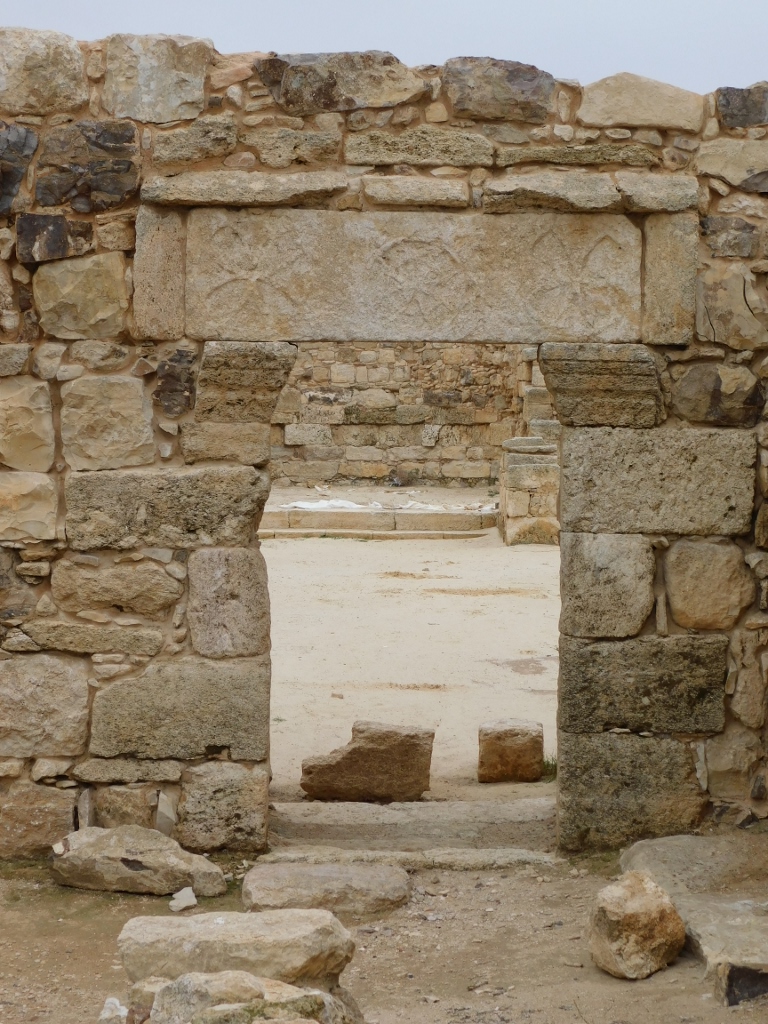 Entrance into the Lions Church: note the decorative lintel
Entrance into the Lions Church: note the decorative lintel
The Lions Church is the only one in Umm er-Rasas with three apses.
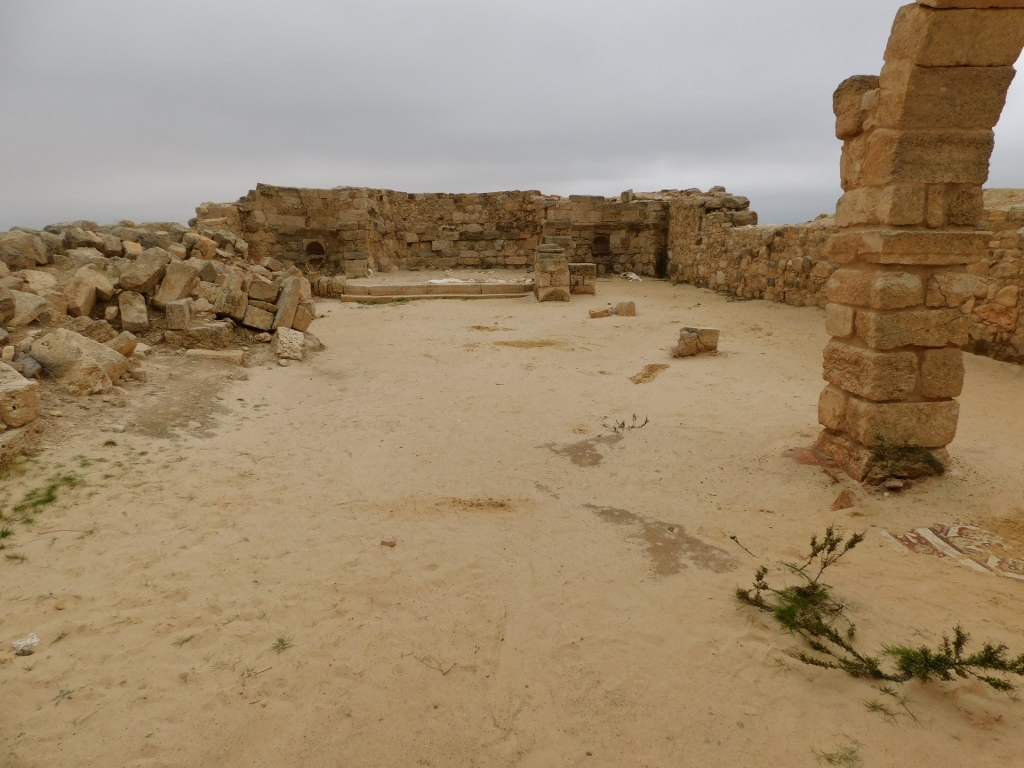 Lions Church: the three apses could be seen in the back
Lions Church: the three apses could be seen in the back
The church got its name after an exceptional mosaic with the motif of two lions that is located on the floor of the presbyterium by the central apse. Unfortunately, or fortunately, the mosaic was covered and protected in order to ensure its preservation.
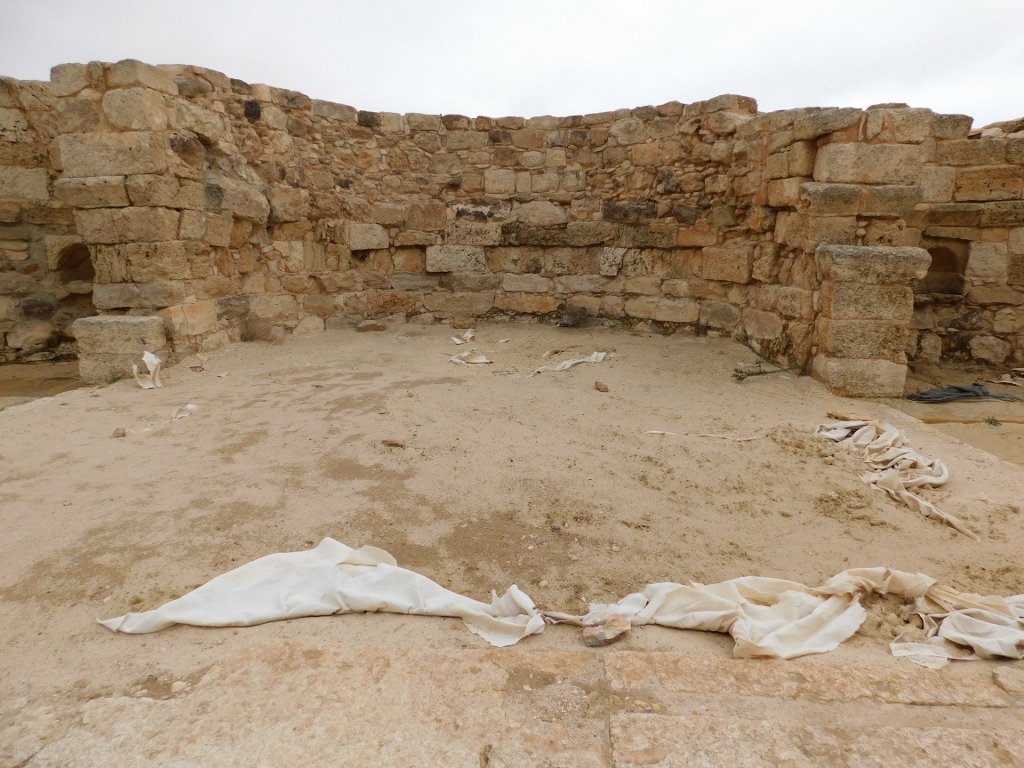 Lions Church: the protected mosaic
Lions Church: the protected mosaic
Still, it was possible to see a part of the floor mosaic in the left apse.
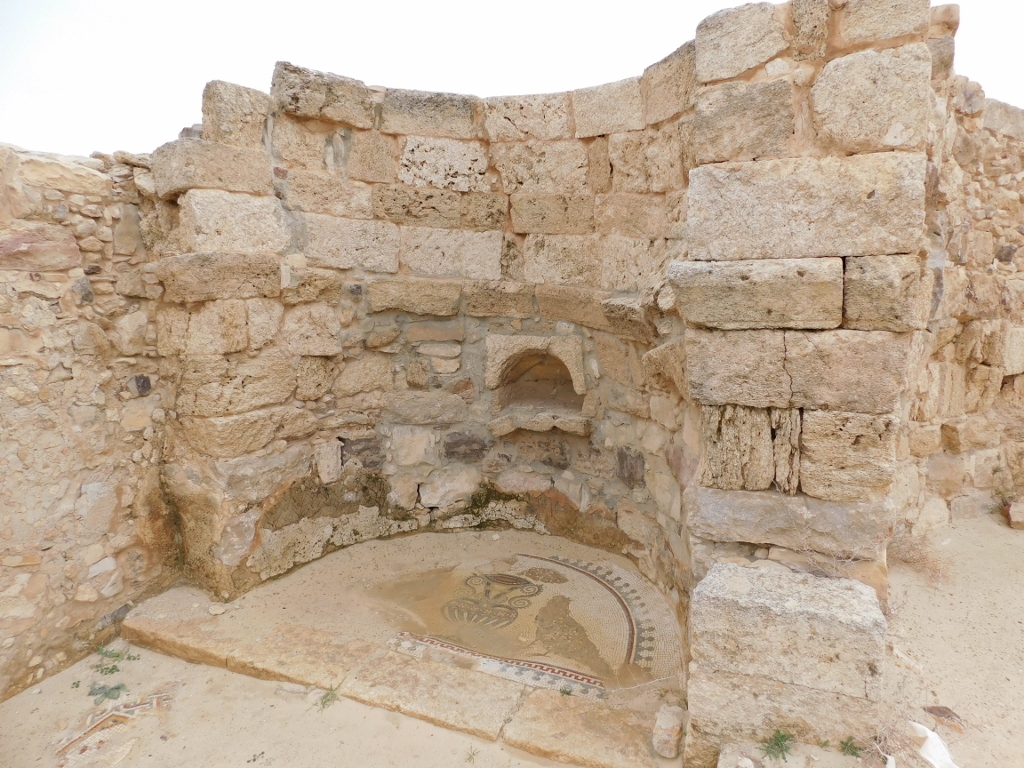 Lions Church: the left apse
Lions Church: the left apse
When you look towards the entrance, you can also see some stairs, as well as an arch that you pass when you enter the area of the church. I liked taking some photos here, bearing in mind also a part of the floor mosaic that can be seen beside the arch’s pillar.
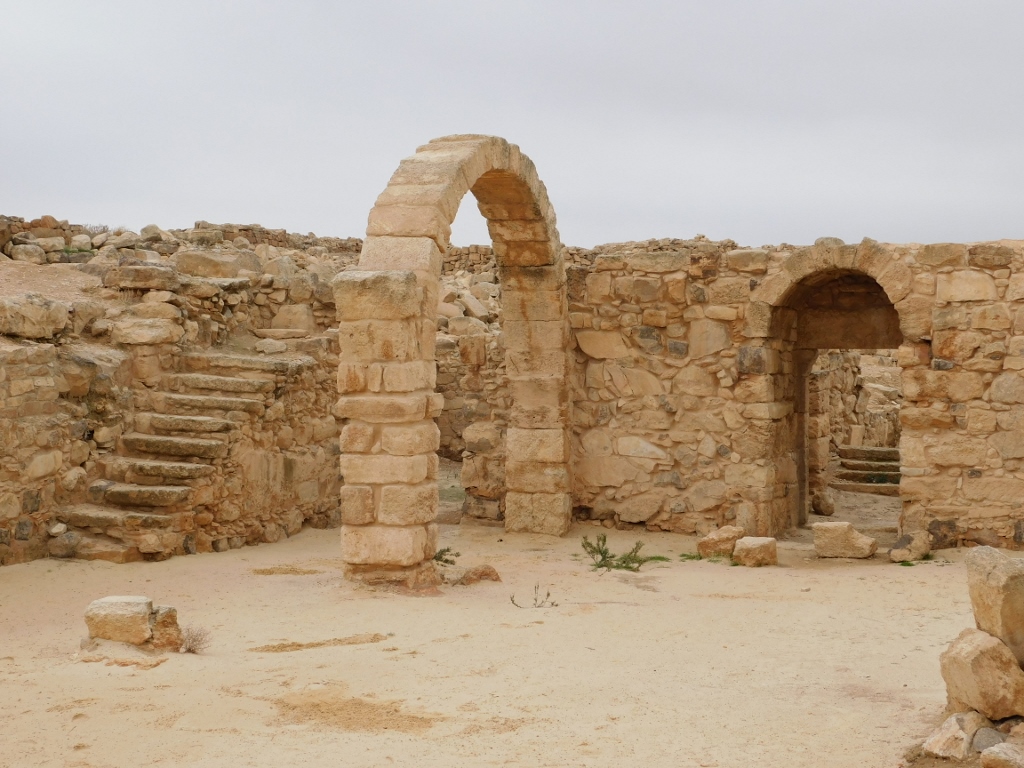 Lions Church
Lions Church
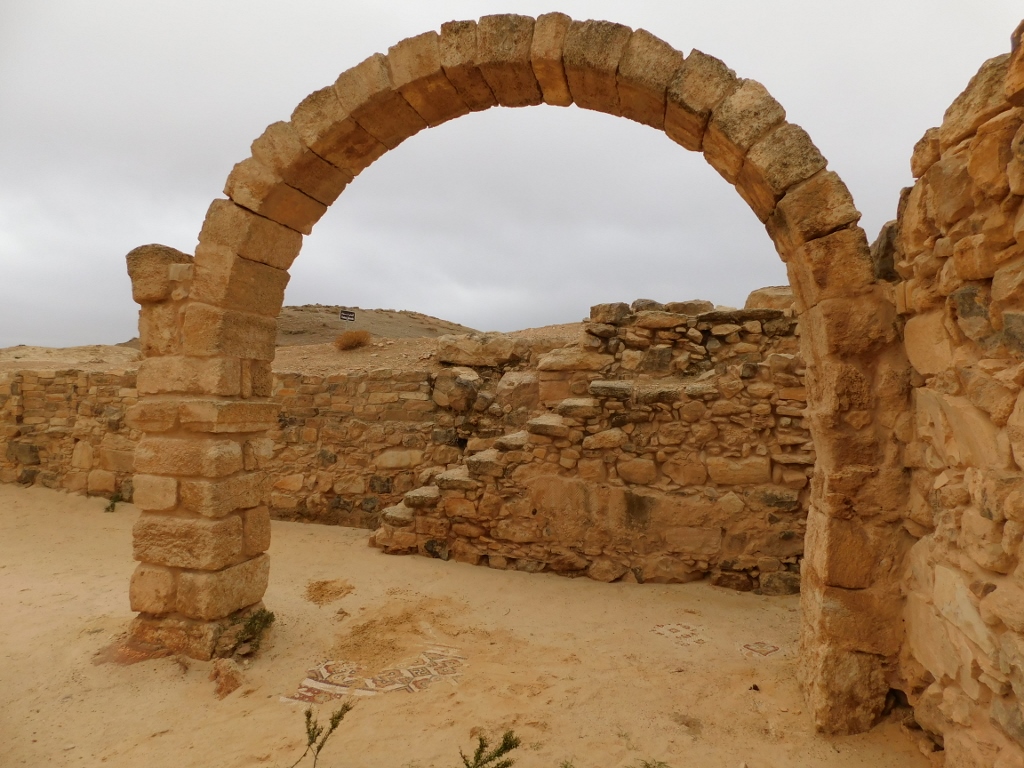 Lions Church: note the mosaic beside the pillar carrying the arch
Lions Church: note the mosaic beside the pillar carrying the arch
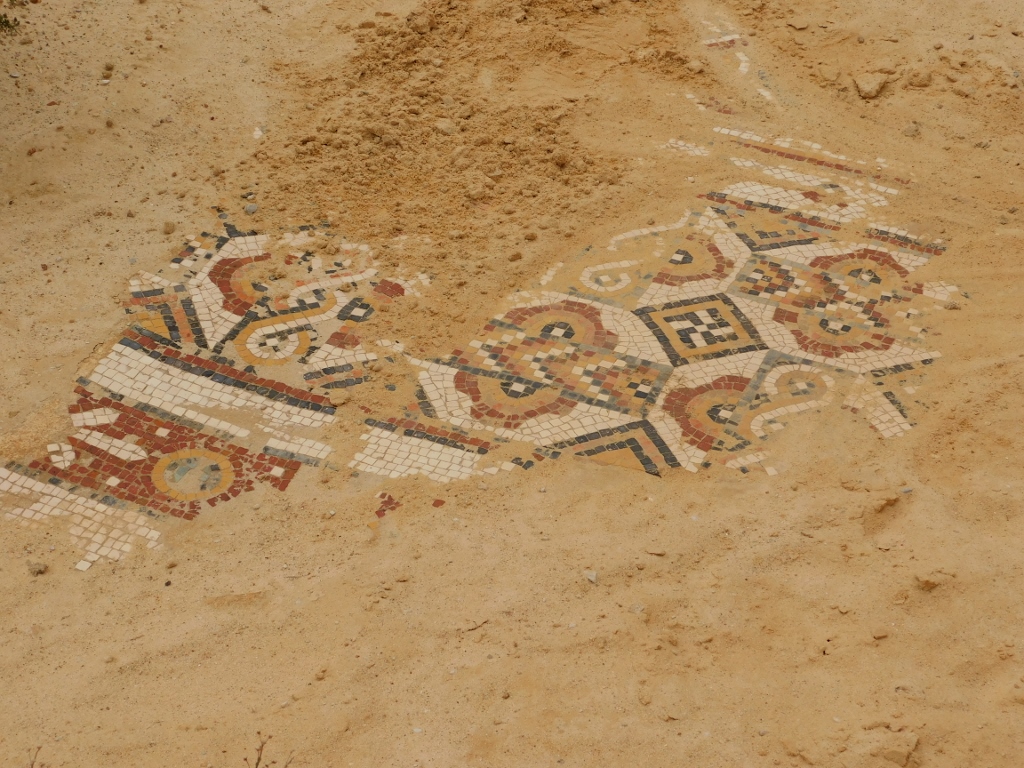
Lions Church, a detail
The next place we visited were the Twin Churches, but in order to get there we had to walk a little bit around. This also allows the visitor to see the degree to which the site has been demolished, but I don’t know if different structures will be reconstructed over time or it will all be just left as it is now.
 Archaeological site Umm er-Rasas
Archaeological site Umm er-Rasas
As for the Twin Churches, they got this name because they were leaned one against the other by their side walls. This could be seen quite nicely if one were to climb the remains of this wall, but I had no intention of doing that, so I have the photos of one and then of the other church.
To start with, there is the Church of the Rivers on the north side of that joint wall that was built in the second haft of the 6th century.
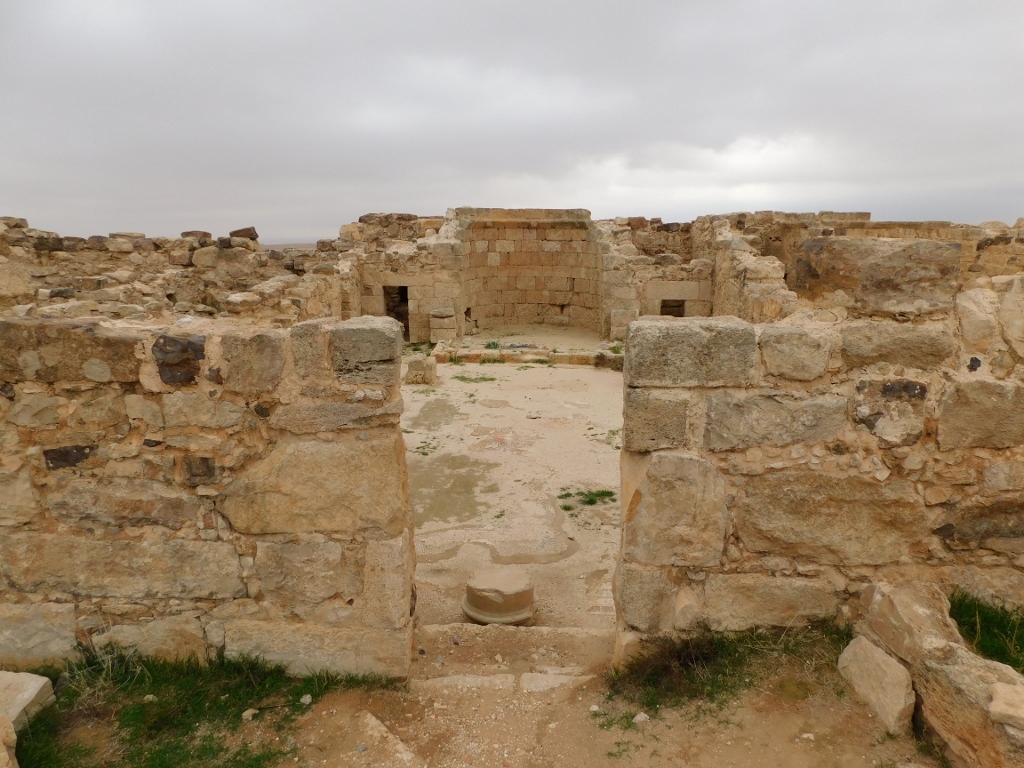 Entrance into the Church of the Rivers
Entrance into the Church of the Rivers
It is presumed that the churches were abandoned already during the Umayyad Period (661-750 CE) and that they were then used for housing or as workshops, but they were definitely destroyed in the 748 earthquake. The Church of the Rivers has one apse and a wide naos divided into three naves by arches (needless to say, only the bases of the pillars carrying the arches could be seen now). To the left and right of the presbyterium there are some smaller auxiliary chambers.
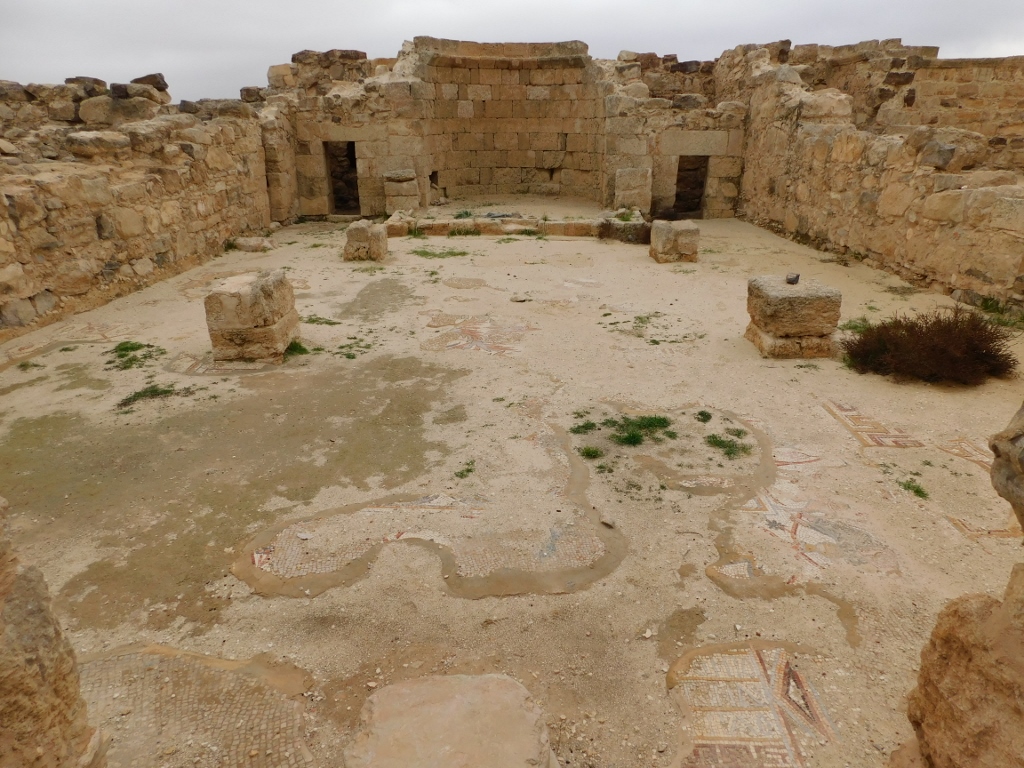 Naos of the Church of the Rivers
Naos of the Church of the Rivers
Despite the fact that during the visit to this church I had no data about it, anybody who looks at this with some attention can notice remains of the floor mosaic that are exceptionally beautiful. The church got its name after the depiction of the personifications of rivers. One should bear in mind that much more of the floor mosaic has survived than what can be seen in the photo above, but a lot has been protected and covered by sand, making it unavailable to the eyes of the visitors. On the other hand, as the wind blows, especially during the winter period, some segments get uncovered.
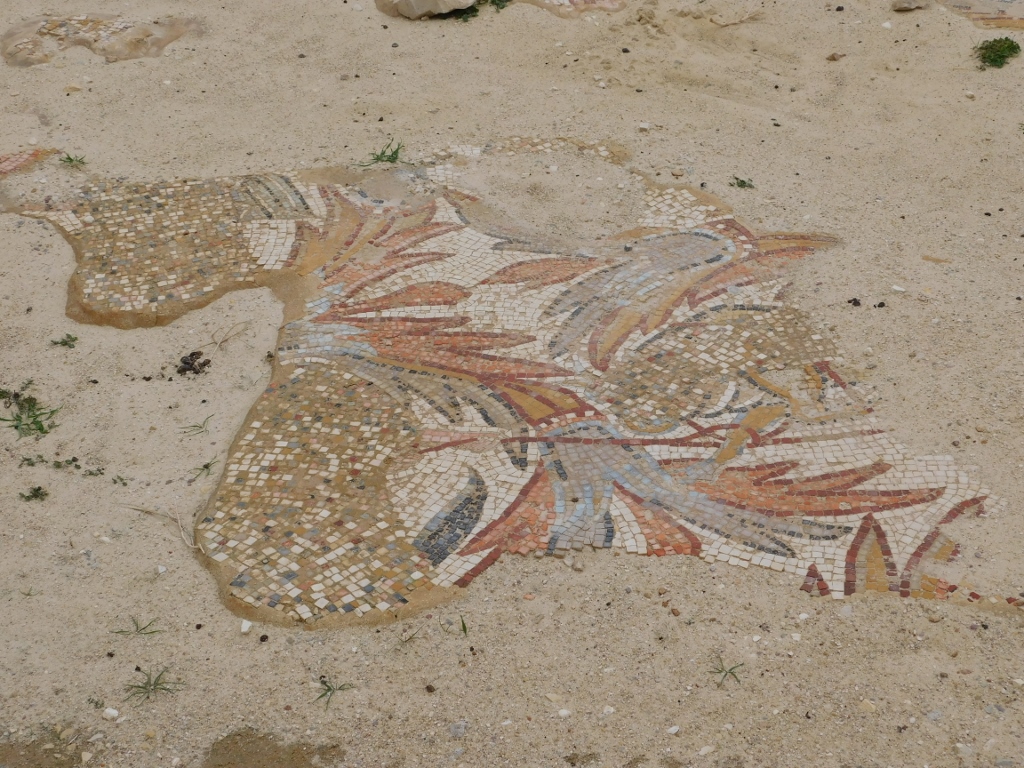 Church of the Rivers, a piece of floor mosaic
Church of the Rivers, a piece of floor mosaic
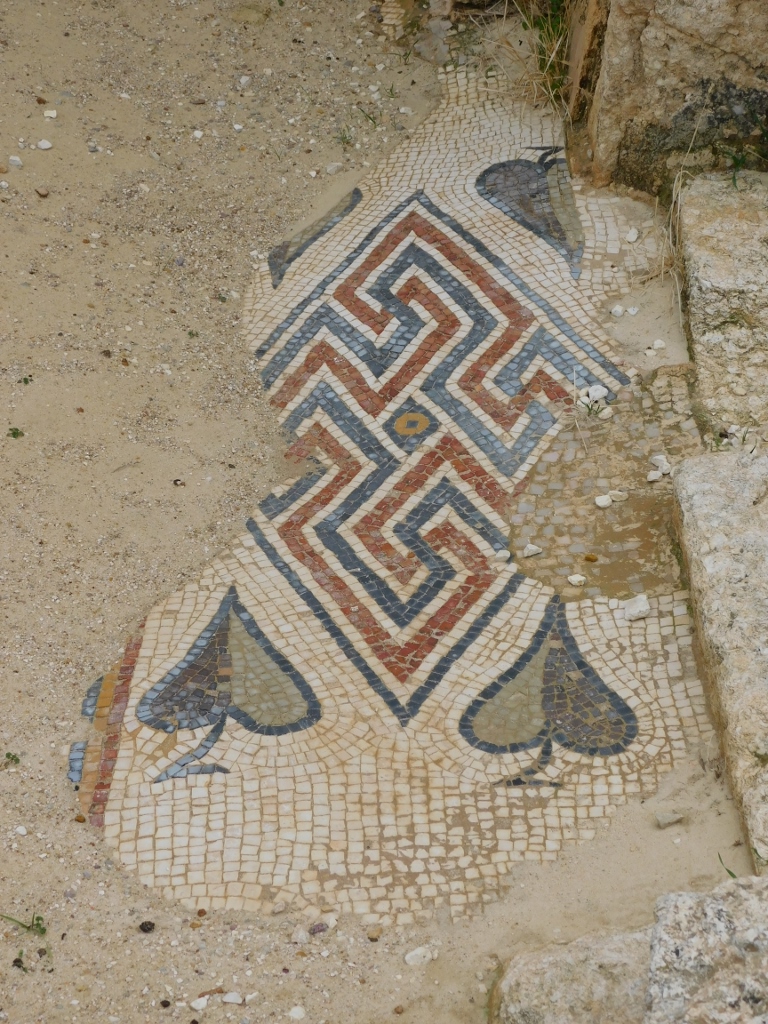 Church of the Rivers, a piece of floor mosaic
Church of the Rivers, a piece of floor mosaic
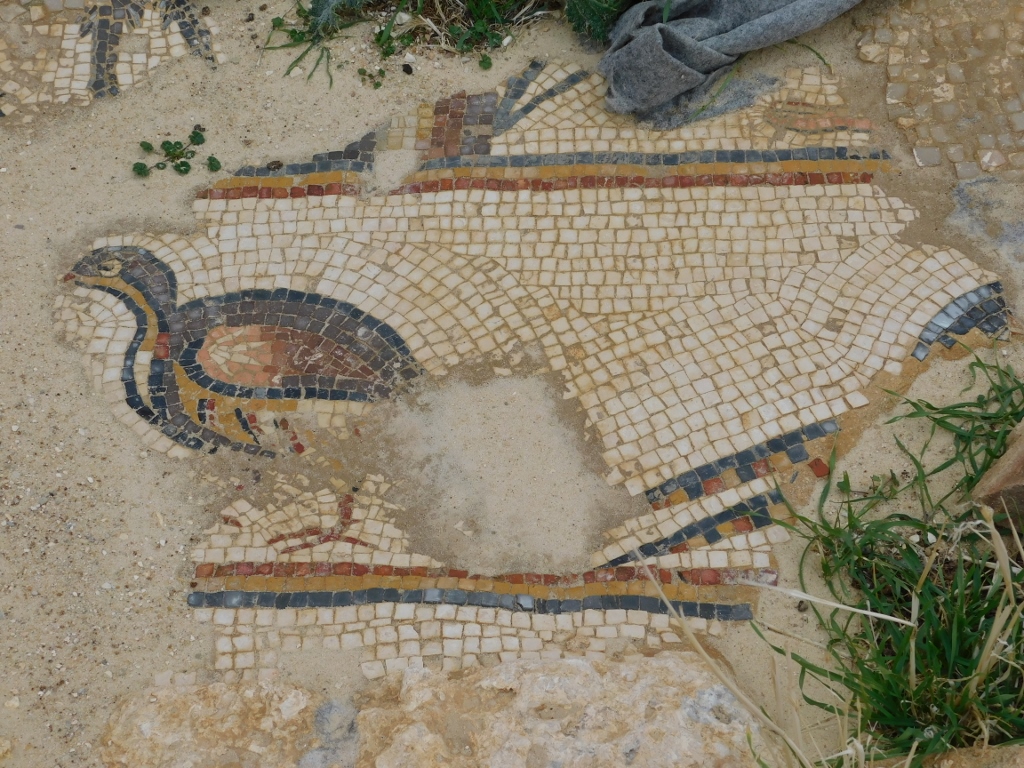 Church of the Rivers, a piece of floor mosaic
Church of the Rivers, a piece of floor mosaic
Then I moved on to the adjacent church, on the south side of the joint wall and that was the Church of the Palm Tree, built at the end of the 6th or the beginning of the 7th century. It got its name after the mosaic depiction of a palm tree in the centre of the presbyterium.
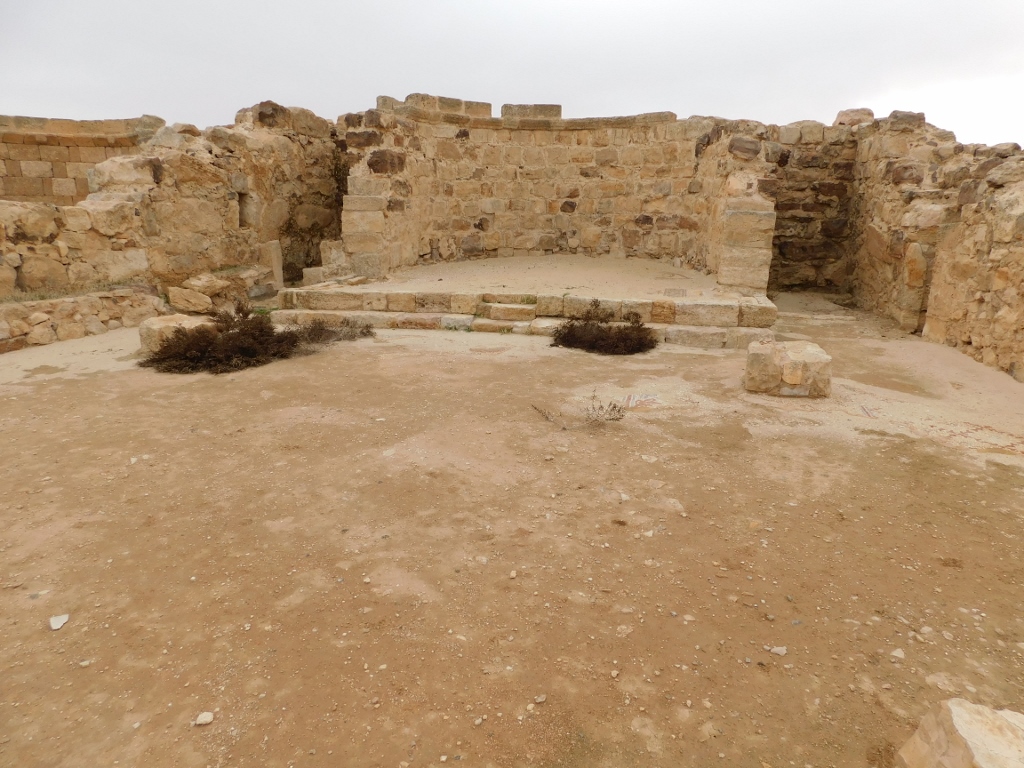 Church of the Palm Tree
Church of the Palm Tree
Like in the case of the previous church, here, too, the sand was piled up over the floor mosaic and I could only see some minor segments.
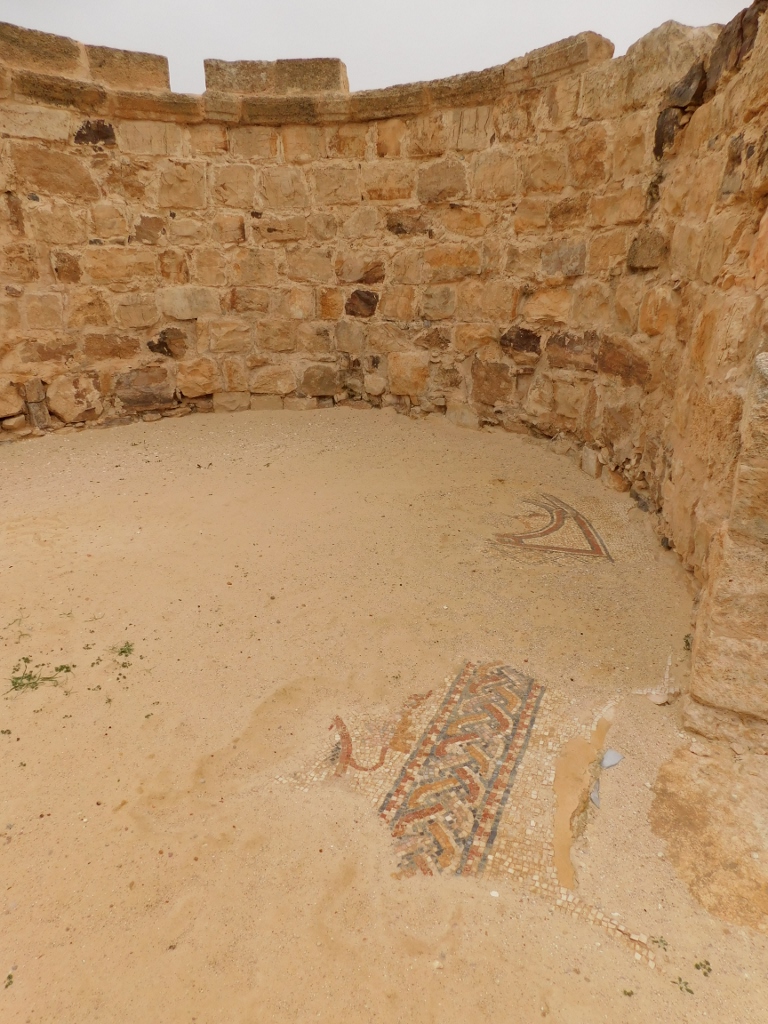 Church of the Palm Tree, a detail
Church of the Palm Tree, a detail
By the way, the temperature was very low (below 10 degrees C), but it was so windy all the time that I would have frozen, had I not applied the system I came up with earlier that morning in Karak when I visited the castle. Over my goose down jacket, I put on my wind-jacket with a hood that I pulled over my head and a wool cap, since the cap itself would just not be enough. Luckily, the wind-jacket was large enough that I could pull this off. Fully accessorised, I had a photo of me taken in the Church of the Palm Tree.
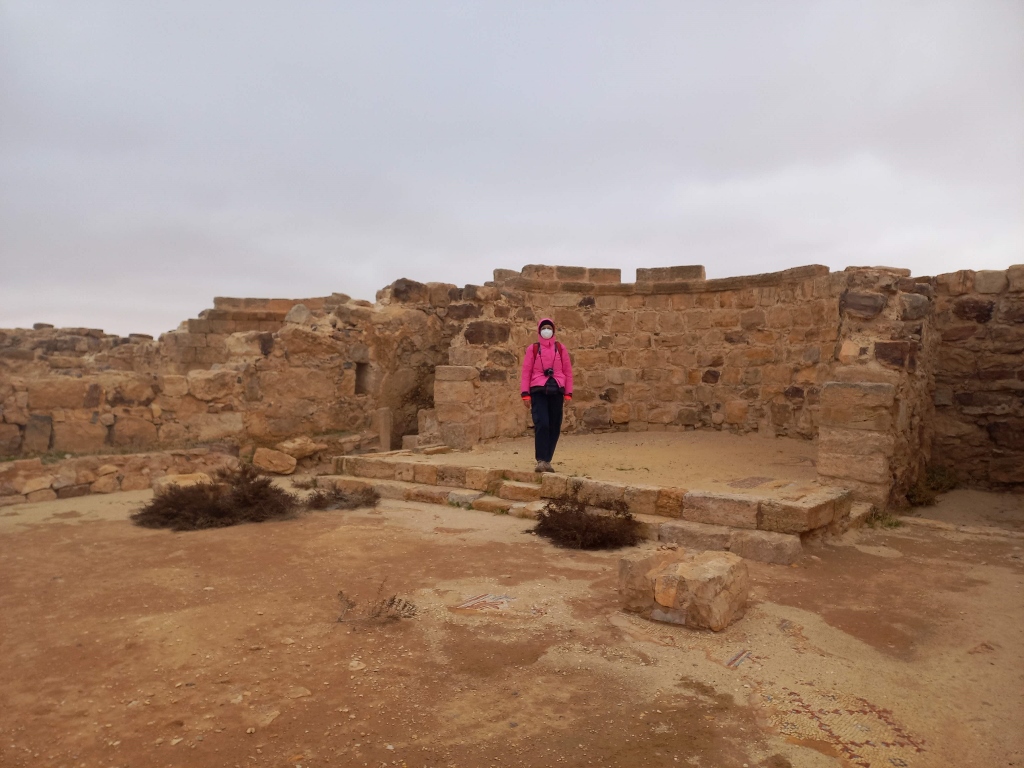 Fully accessorised at the Church of the Palm Tree
Fully accessorised at the Church of the Palm Tree
Note the face mask I’m wearing. Although I was in Jordan during the coronavirus pandemic, it is absolutely clear that I did not need the mask here at all in order to protect myself from the virus – there was simply nobody else around. But, wearing the mask felt exceptionally good, for it warmed the air I was breathing, since the air cooled down by the wind seemed way too cold.
After the photo-shoot, Abdullah and I also visited remains of the Church Market.
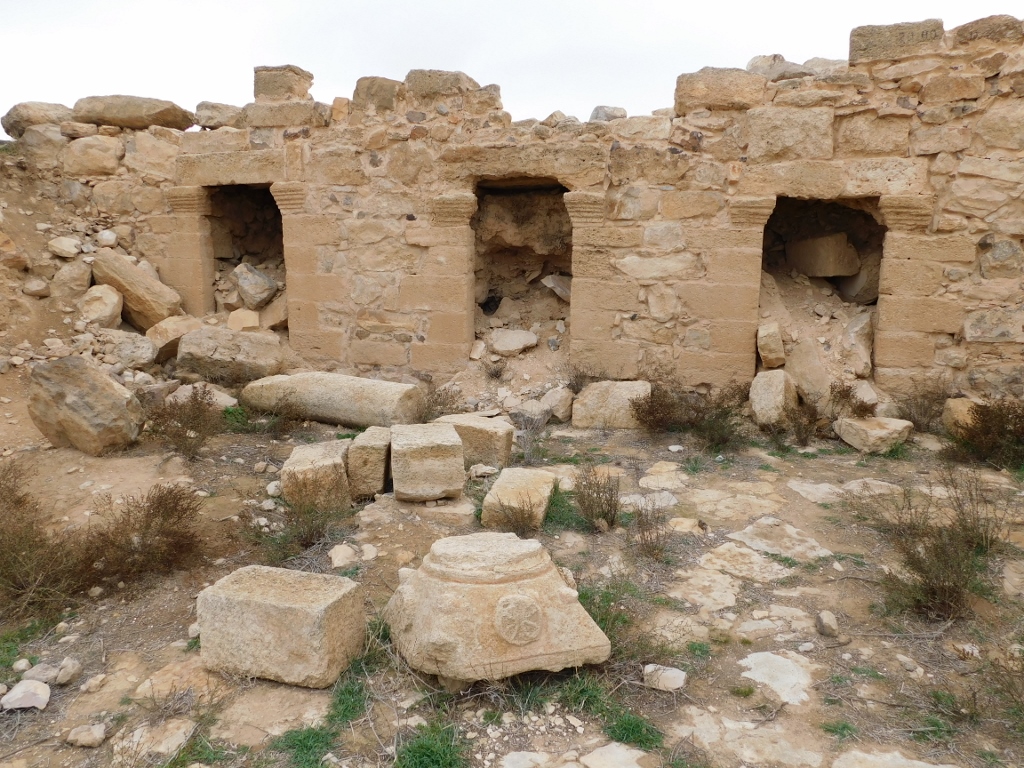 Remains of the Church Market
Remains of the Church Market
Now came the time to head for the main structure at the archaeological site Umm er-Rasas, but on our way there we came to yet another church, i.e., to its remains. This was the Church of Saint Paul. The church was given this name because of the name of the saint that was found incised on a roof tile.
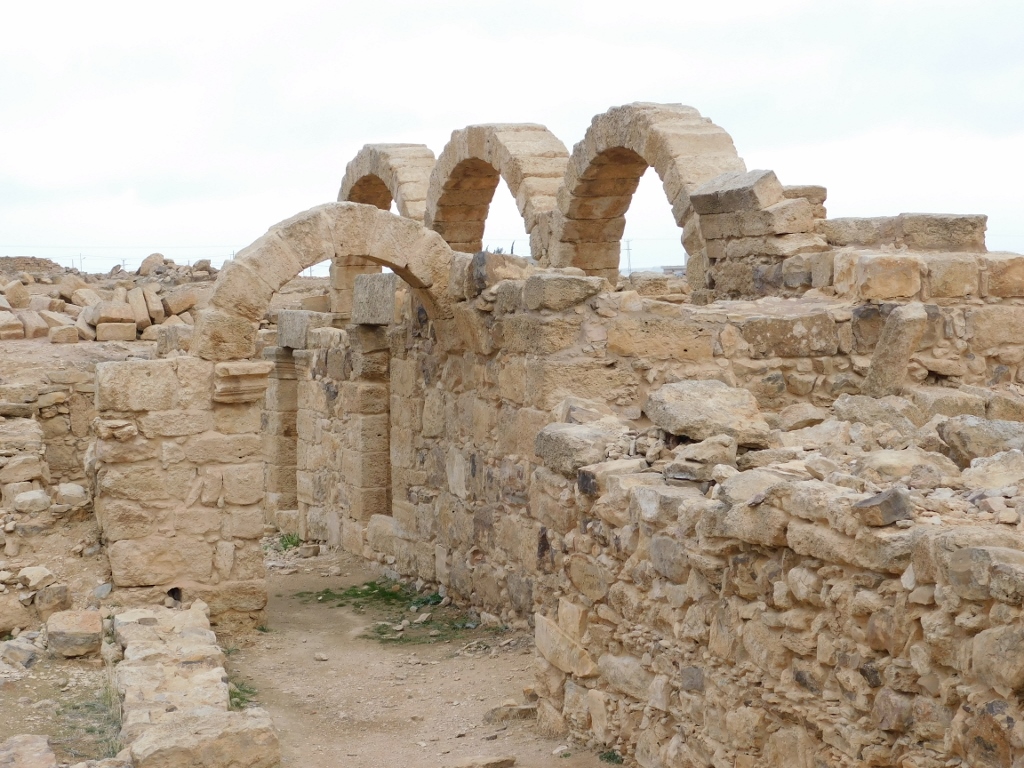 Church of Saint Paul
Church of Saint Paul
When you enter the area of the naos, you can see nicely on one side the reconstructed wide arches that lead from one end of the apse, thus suggesting how the space was divided into three naves, since there were such arches on the other side as well.
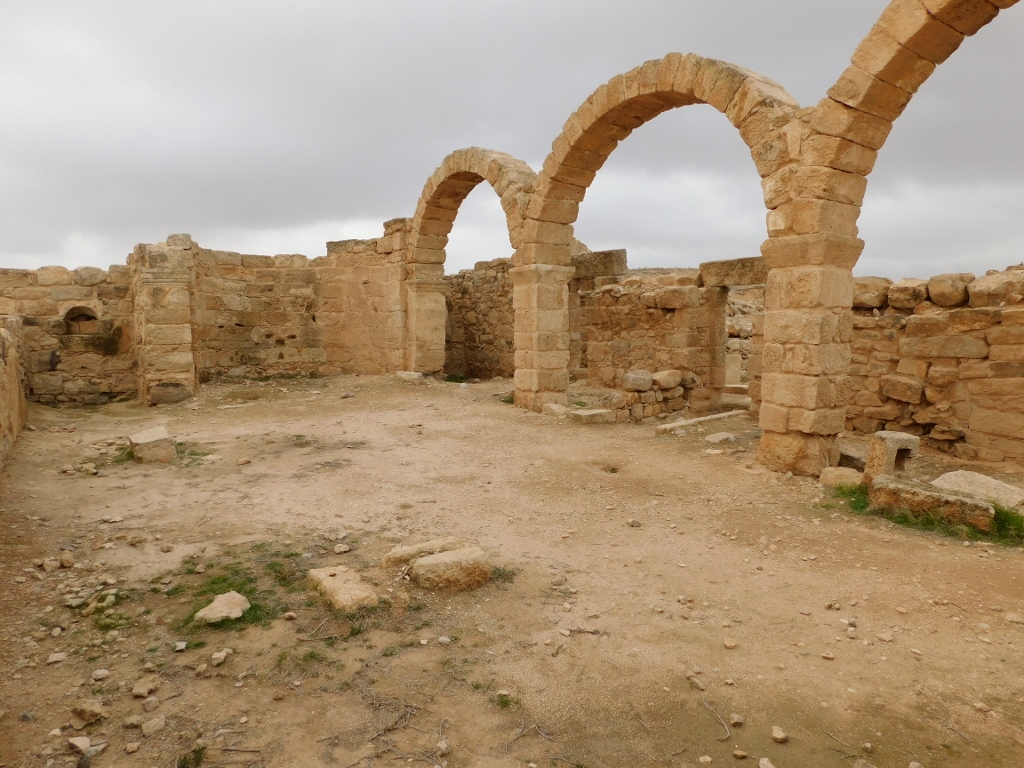 Church of Saint Paul, a detail
Church of Saint Paul, a detail
And now, we could finally head for St. Stephen’s Complex that is completely protected against the major external influences.
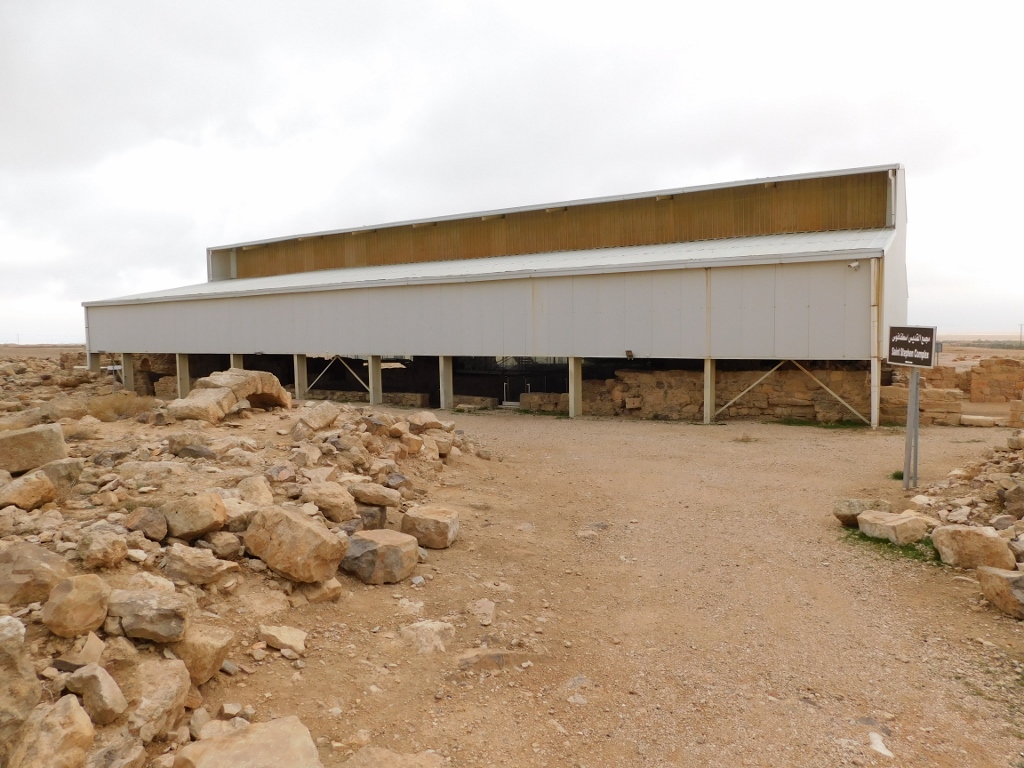 St. Stephen’s Complex within the archaeological site Umm er-Rasas
St. Stephen’s Complex within the archaeological site Umm er-Rasas